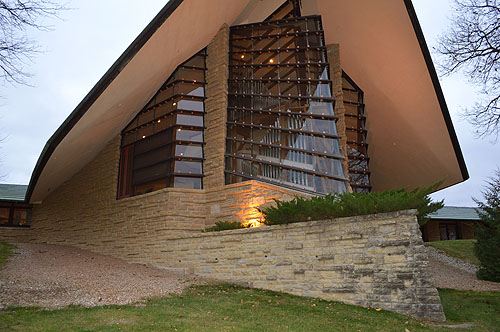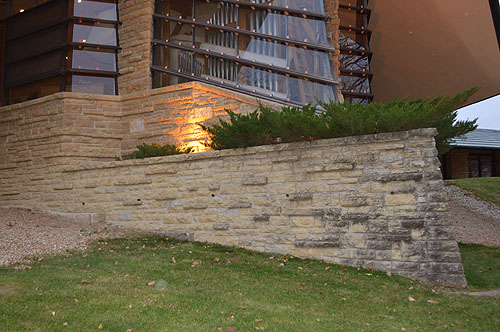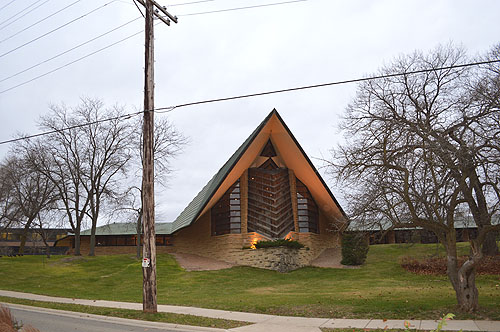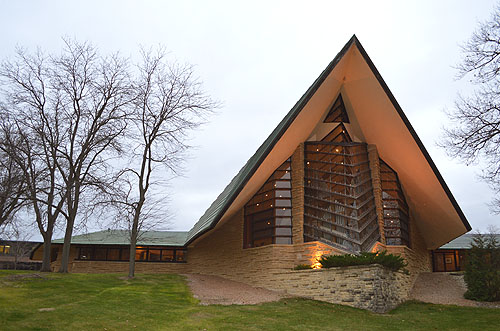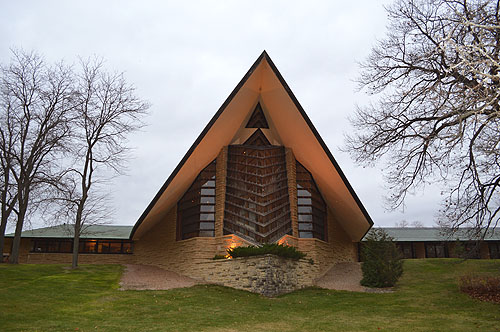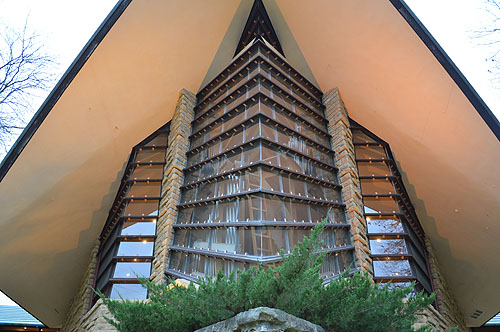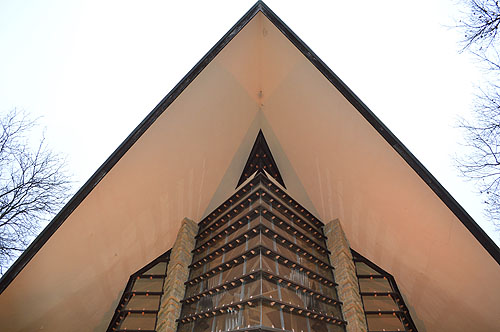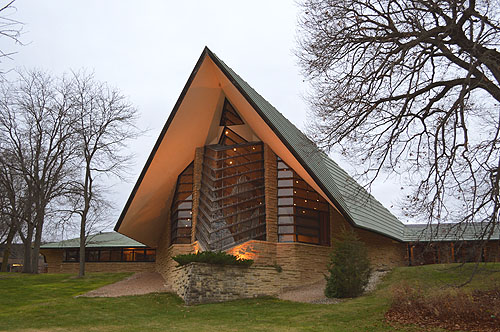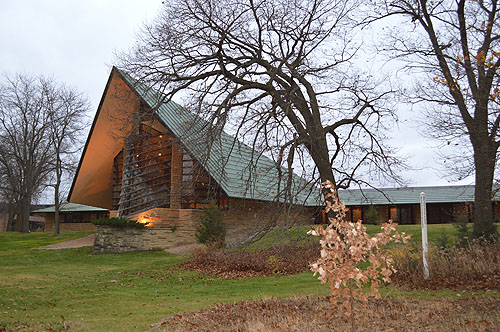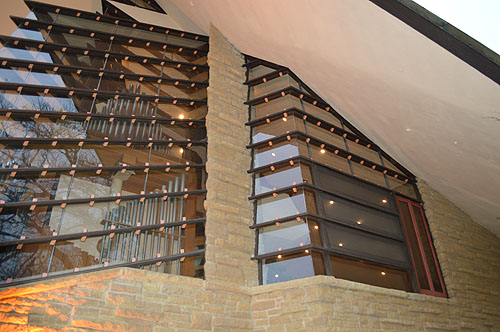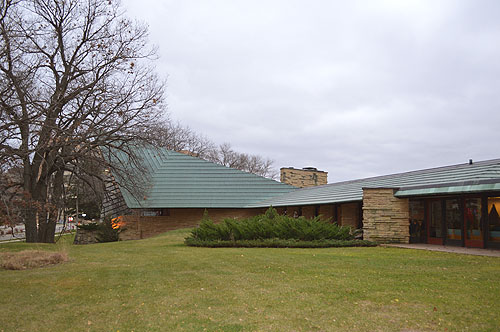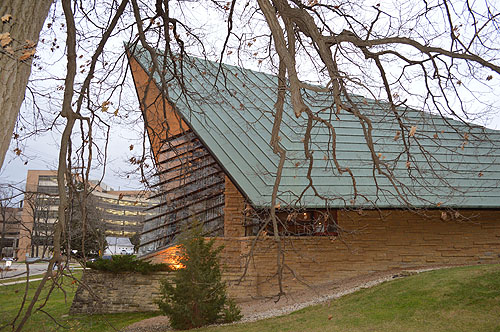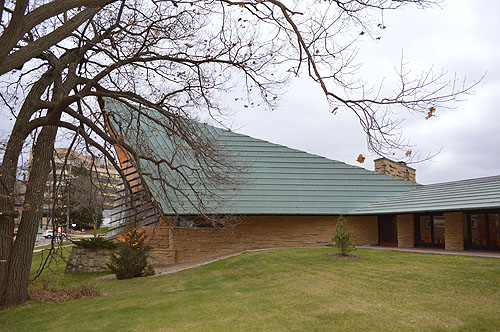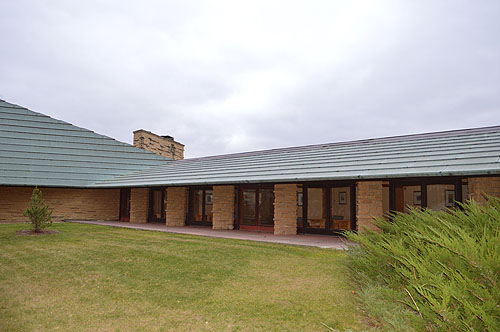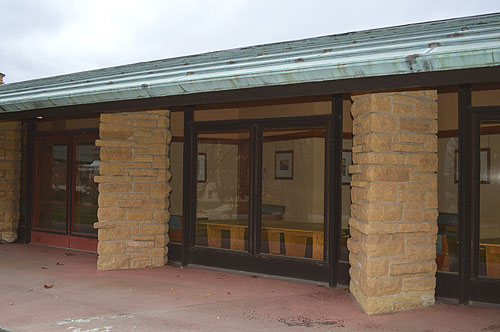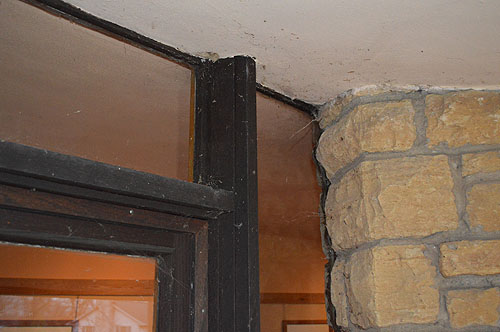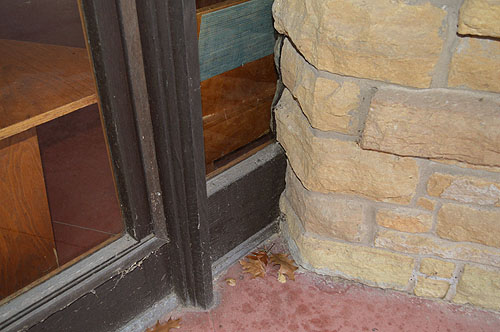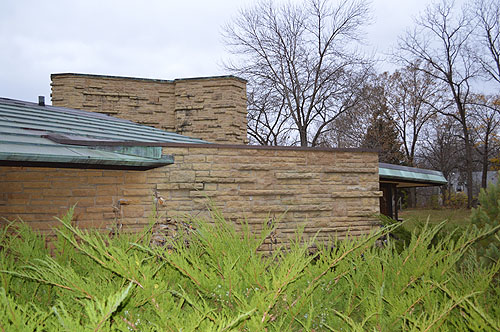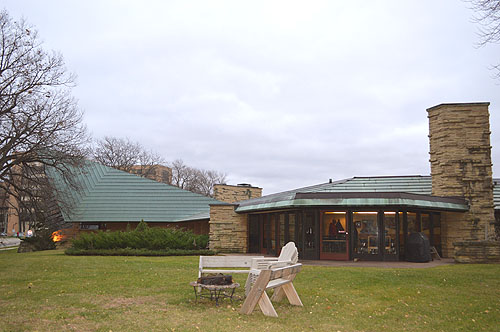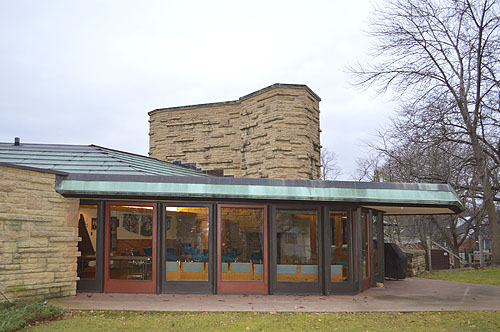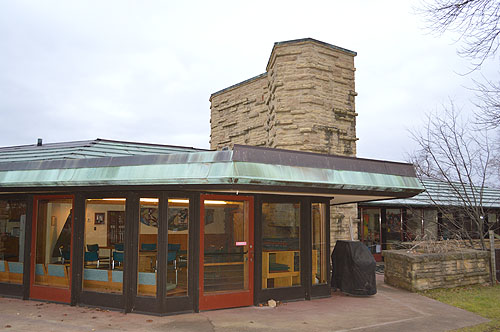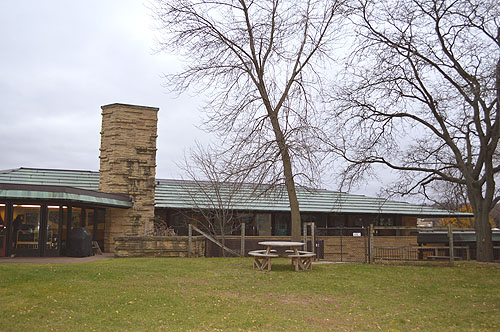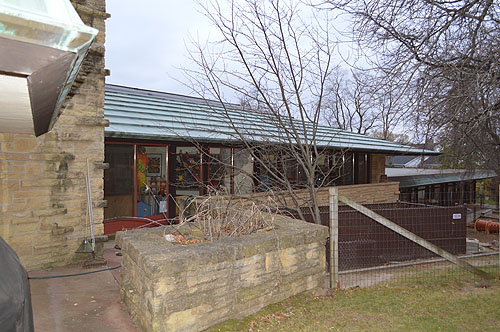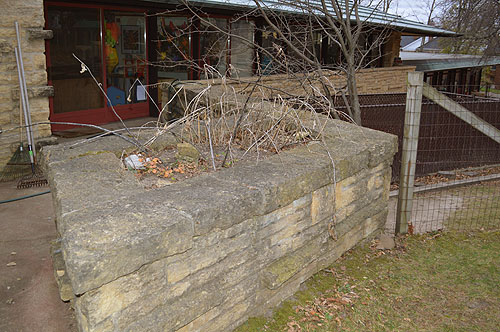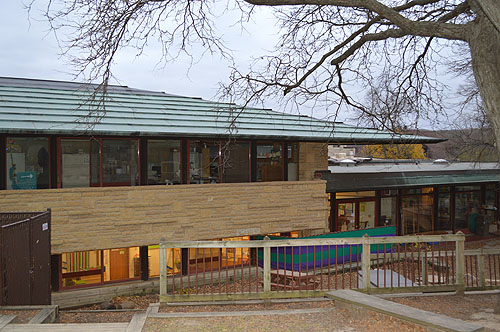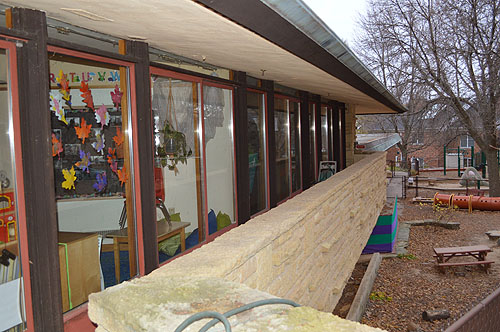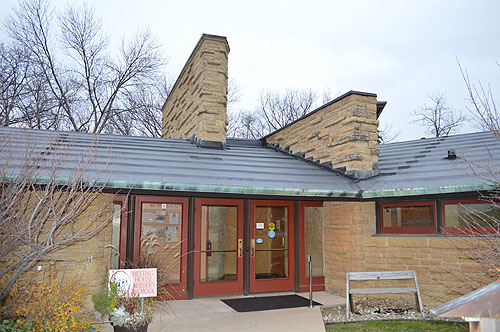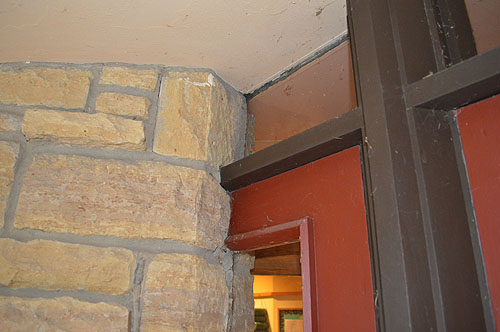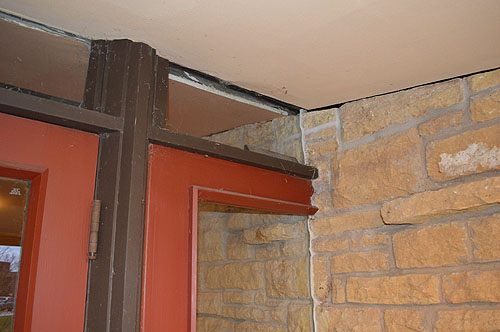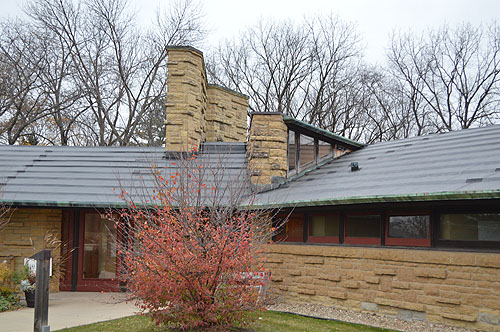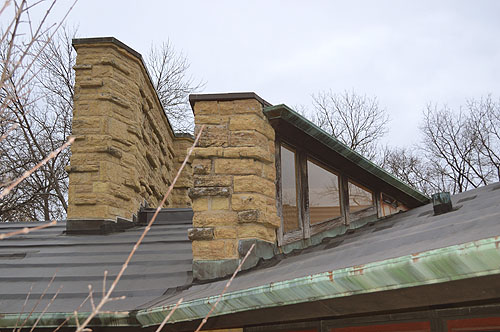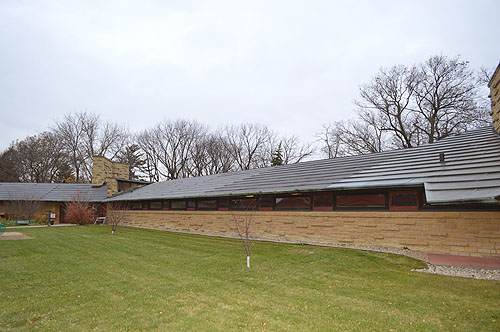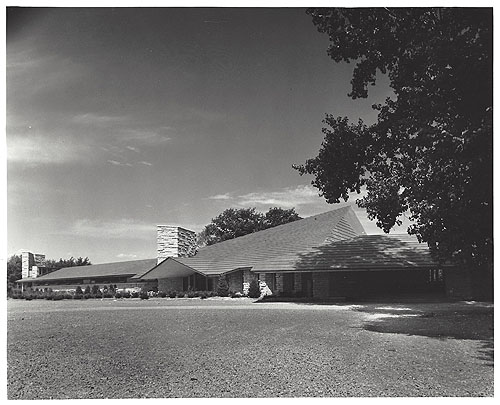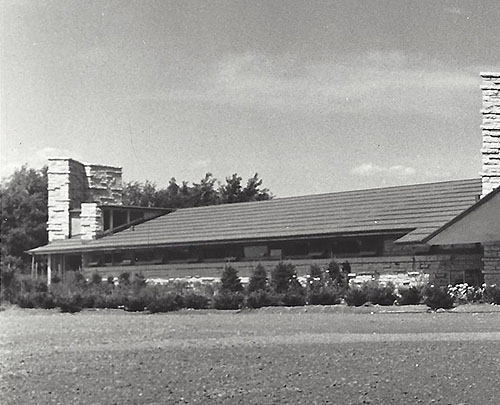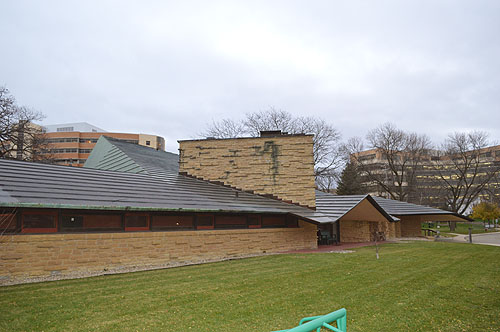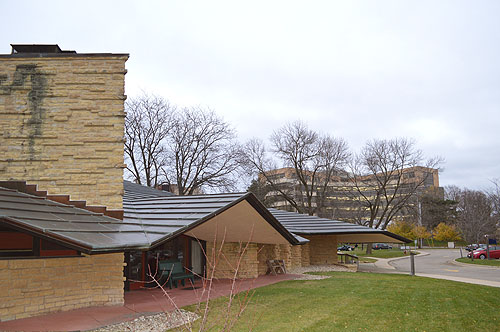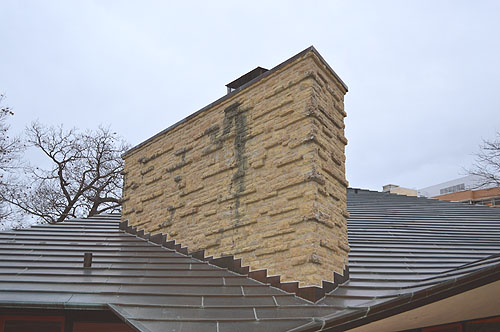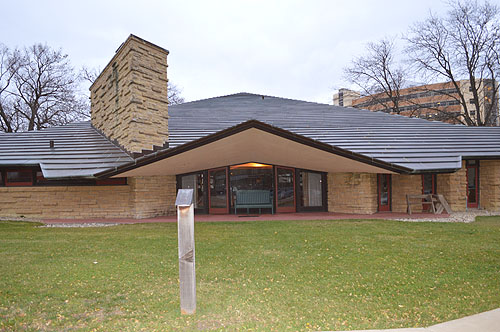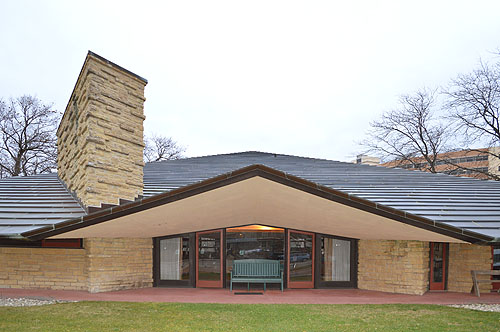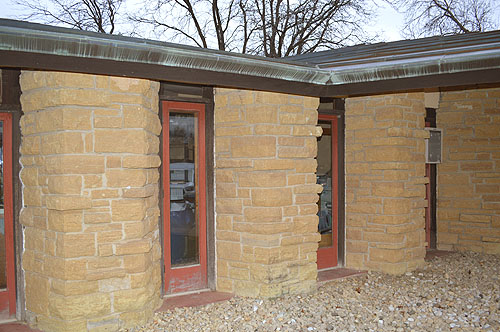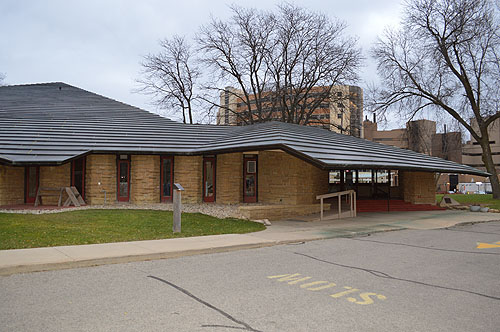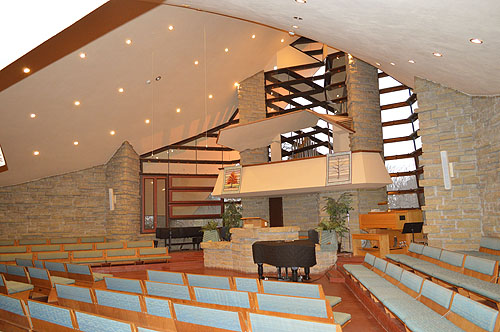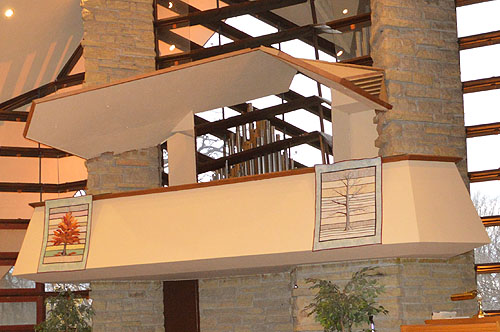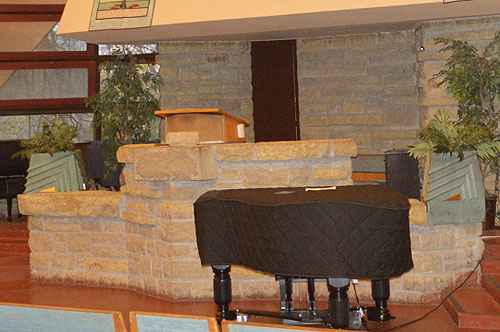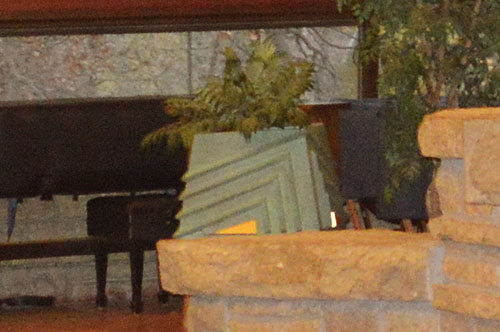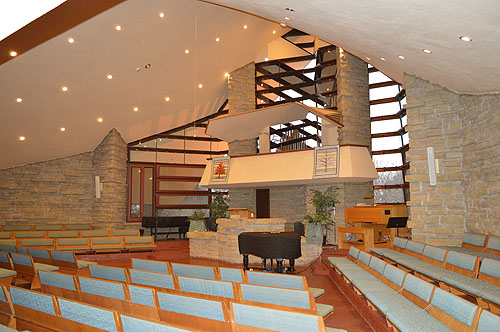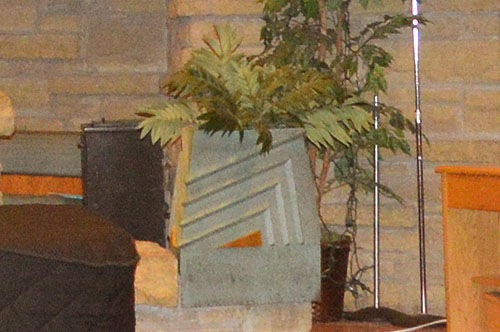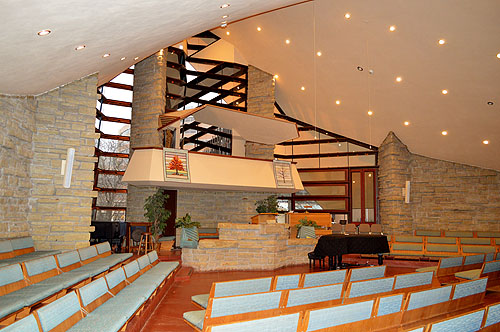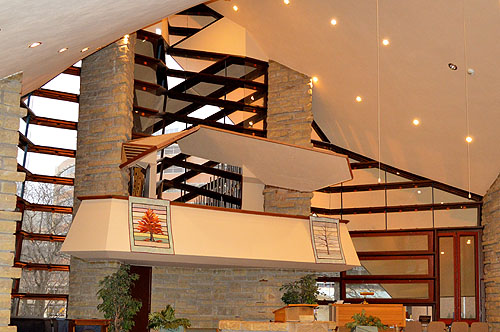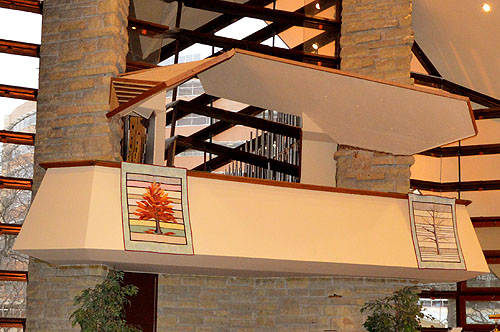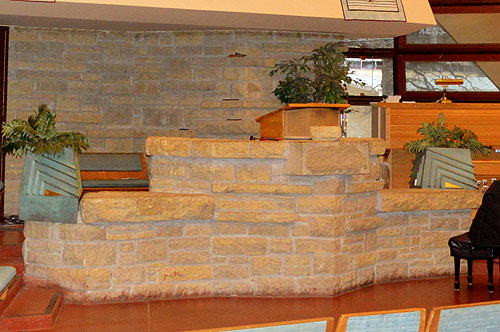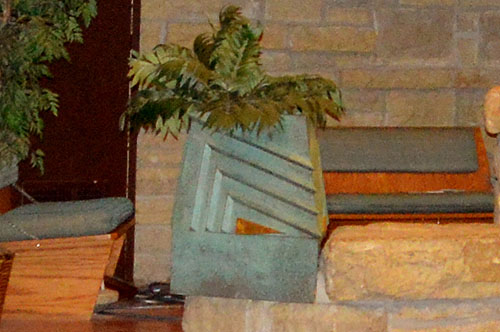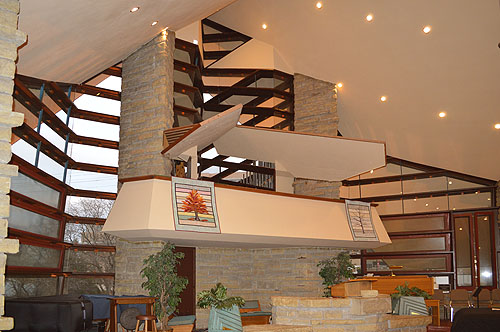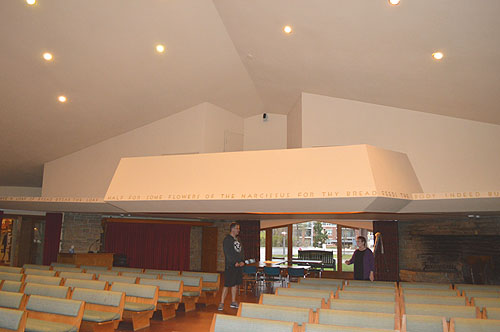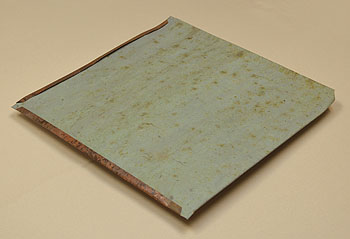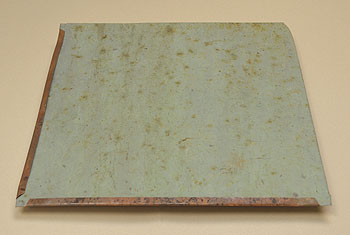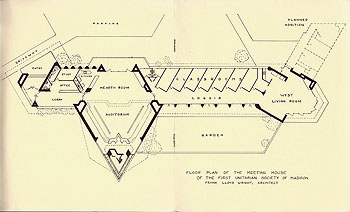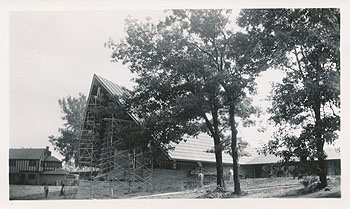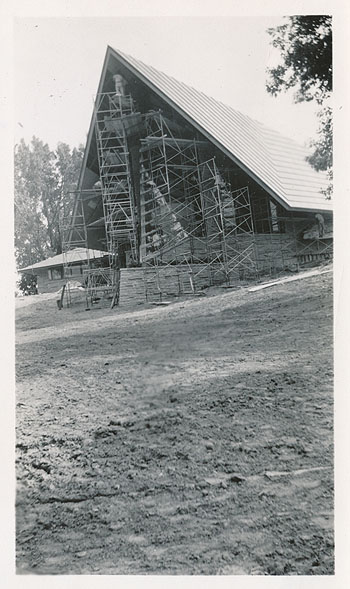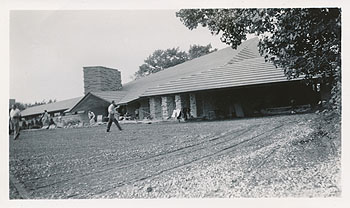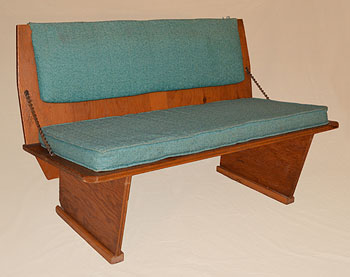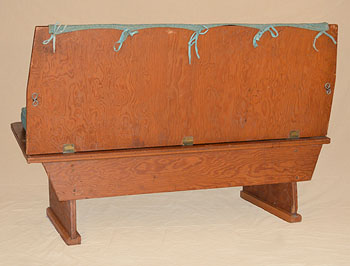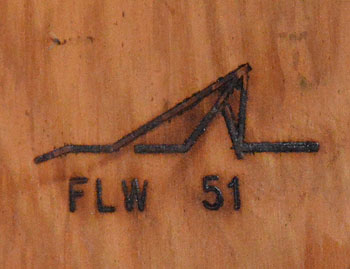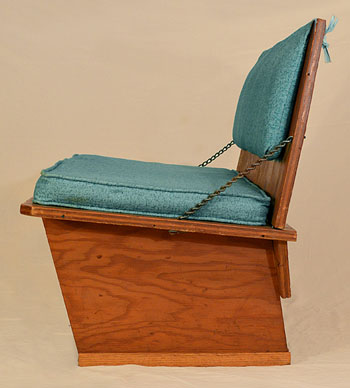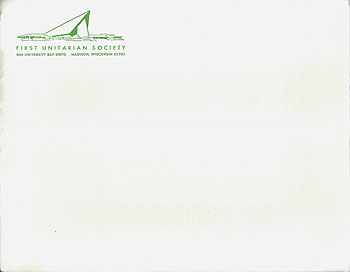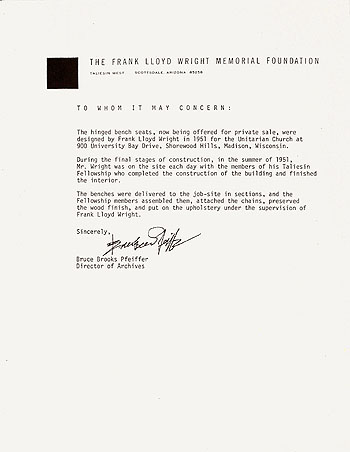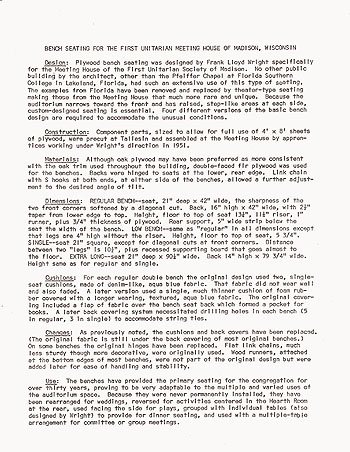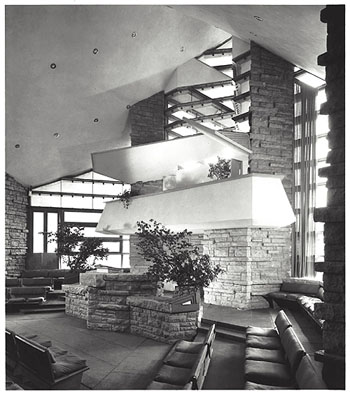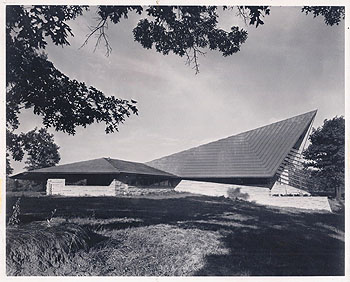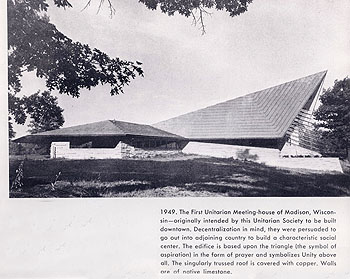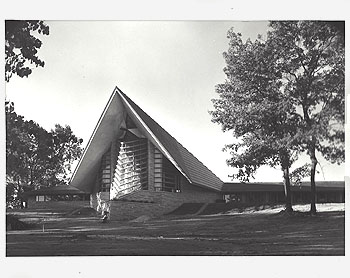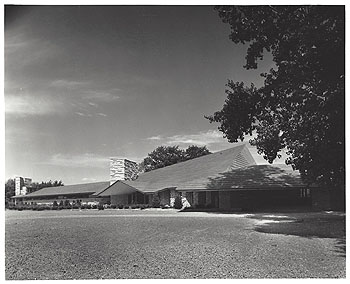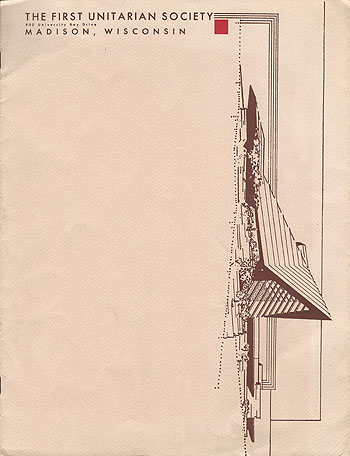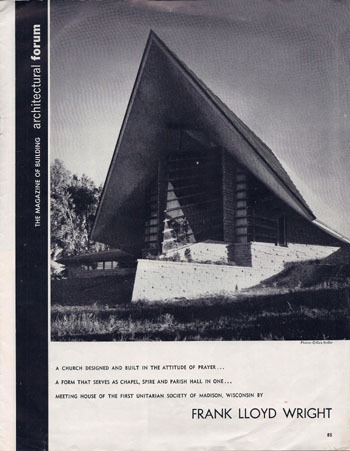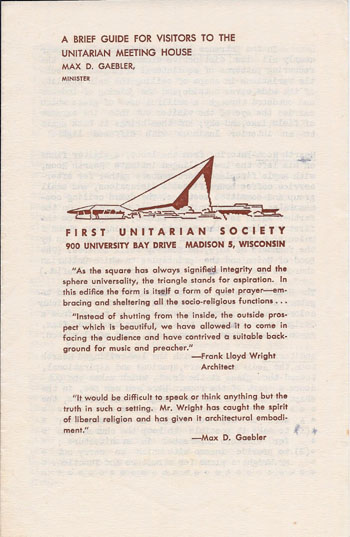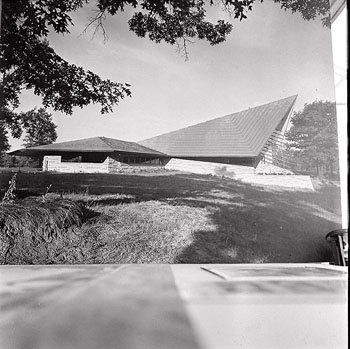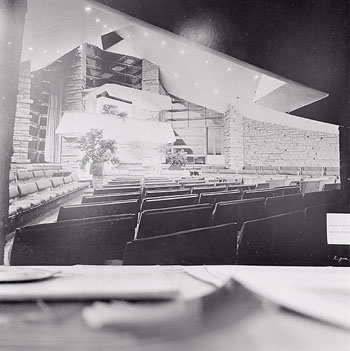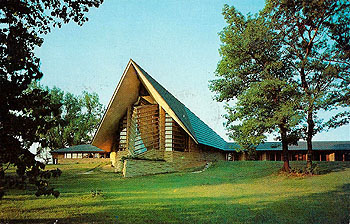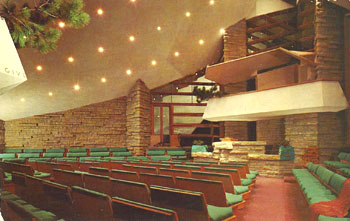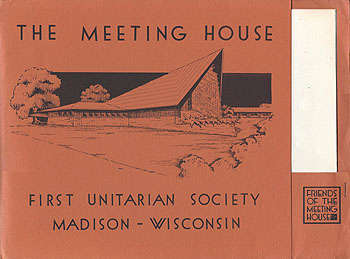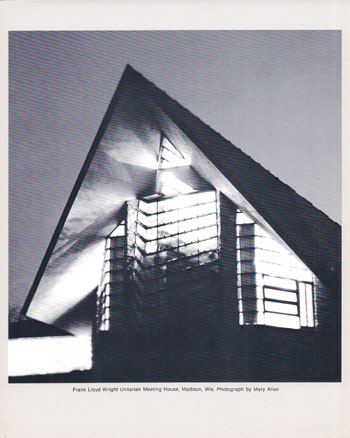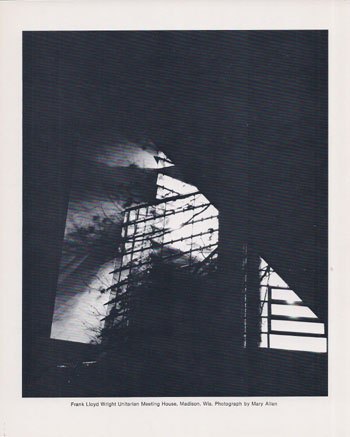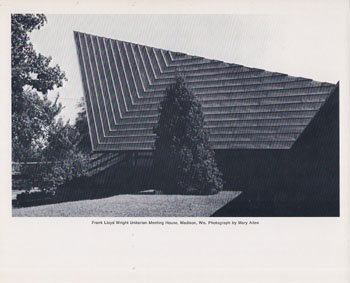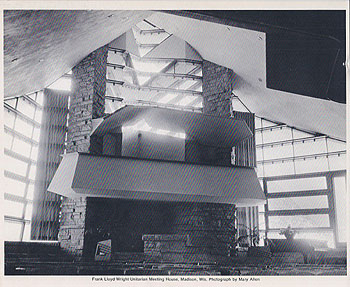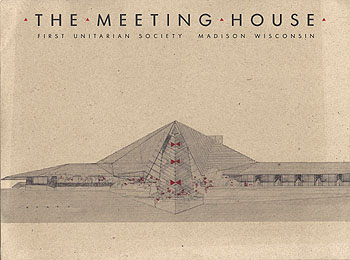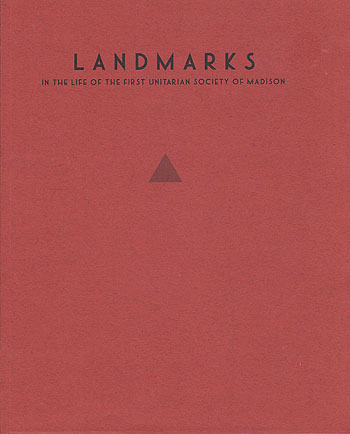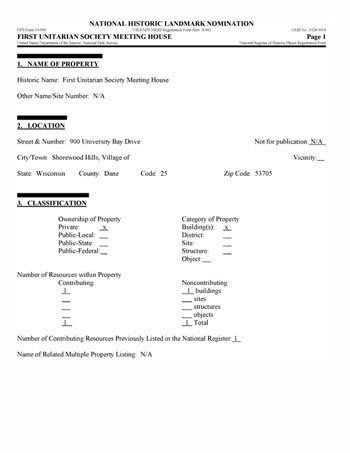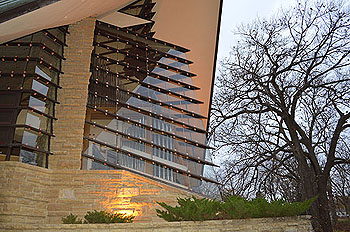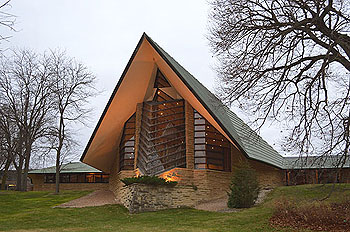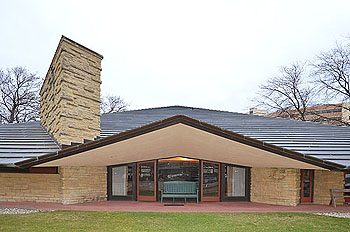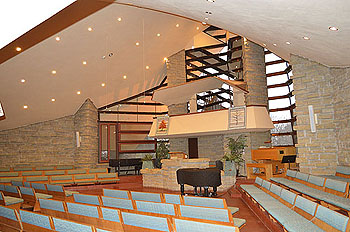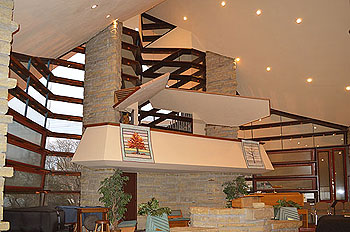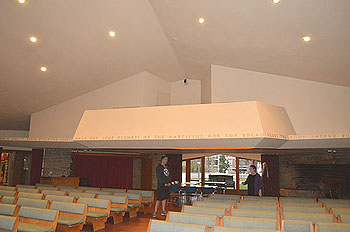
NOW AVAILABLE
CLICK TO ORDER
Unitarian Meeting House (1947 - S.291)
INTRODUCTION FLOOR PLAN ARCHITECURAL FORUM 1948 PEW/BENCH 1951 2016 EXTERIOR 2016 INTERIOR ITEMS Introduction
Designed in 1947, construction began in 1949. On August 21, 1951, the church opened with a lecture by Frank Lloyd Wright and a performance by the Taliesin Fellowship musicians. In 1960, the American Institute of Architects designated it as one of 17 examples of Wright's contribution to American culture. It was placed on the National Register of Historic Places in 1973. "...I tried to build a building here that expressed that over-all sense of unity. The plan you see is triangular. The roof is triangular and out of this – triangulation – (aspiration) you get this expression of reverence without recourse to the steeple.
"The building itself, covering all, all in all each in all, sets forth – says what the steeple used to say, but says it with greater reverence, I think, in both form and structure." Frank Lloyd Wright, 1953. The design is based on the triangle. The equilateral parallelogram, a diamond formed by two triangles, is scored into the concrete, and forms the basis for the design. The walls are native limestone, hauled by the parishioners from a quarry 30 miles away. The roof is covered in copper.
November 18, 2016Unitarian Meeting House Floor Plan Floor Plan courtesy of The Frank Lloyd Wright Foundation, adapted by Douglas M. Steiner. Architectural Forum - January 1948
"The structure is Unitarian in character, trusting to a sense of the altogether as more beautiful than the aggregation of steeple, meeting house and parsonage could ever be. In this design, the social activities of the members of the congregation are served by the Church Auditorium itself.
"In front of the Auditorium, beautiful views of distant Lake Mendota frame the pulpit on either side. The preacher and the choir are at this apex of the main triangle. The whole triangleis the center of the plan, and the apex of the triangle is a stone mass of perforated pattern. The perforations are closed by colored glass making the mass resemble the rose window of an antique church. Otherwise, it is the mass of the structure that is depended upon to give the impression of aspiration usually left to the steeple. The walls are to be made of native stone, the interior framing wood, and the roofs copper." Frank Lloyd Wright, Architectural Forum, January, page 118-119. Courtesy of Architectural Forum.
Caption: "Decentralization. Unitarian Church in the country on spacious grounds near Madison, Wisconsin, April 1947." The drawing is dated April 20, 47. Note, published on the page at this angle. Courtesy of Architectural Forum. Adaptation of the published illustration by Douglas M. Steiner. Text: "Section of Center Line." Courtesy of Architectural Forum. East Elevation. Courtesy of Architectural Forum. North Elevation. Courtesy of Architectural Forum. "Country Church. Floor Plan. For the First Unitarian Society, Madison Wisconsin. Frank Lloyd Wright Architect." Courtesy of Architectural Forum. Anatomy of a Wright Designed Pew/Bench (1951)
Designed in 1947, construction began in 1949. On August 21, 1951, the church opened with a lecture by Frank Lloyd Wright. "Plywood bench seating was designed by Frank Lloyd Wright specifically for the meeting house of the First Unitarian Society of Madison. No other public buildings by the architect, other than the Pfeiffer Chapel at Florida Southern College in Lakeland, Florida, had such an extensive use of this type of seating... Component parts, sized to allow for full use of 4’ x 8’ sheets of 3/4" plywood, were precut at Taliesin and assembled at the Meeting House by apprentices working under Wright’s direction in 1951... Four benches were designed, Regular, Low, Single and Extra Long. Cushions: For each regular double bench the original design used two, single seat cushions, made of denim-like, aqua blue fabric. That fabric did not wear well and also faded. A later version used a single, much thinner cushion of foam rubber covered with a longer wearing, textured, aqua blue fabric. The original covering included a flap of fabric over the bench seat back which formed a pocket for books. A later back covering system necessitated drilling holes in each bench to accommodate string ties. The benches provided the primary seating for the congregation for over 30 years, proving to be very adaptable to the multiple and varied uses of the
auditorium space..." Descriptive sheet, 1983. "When the old fir plywood benches were later replaced with benches made of oak-veneer plywood (as Wright had intended), the fabric and cushion style again replicated the originals." National Historic Landmark Nomination, First Unitarian Society Meeting House, 2004. Each Pew includes documentation which includes: 1) First Unitarian Society envelope 11.25 x 8.75. 2) Letter from Bruce Brooks Pfeiffer, The Frank Lloyd Wright Memorial Foundation. Taliesin West, Scottsdale Arizona, 8.5 x 11. 3) Descriptive Sheet, 8.5 x 11. 4) Original 8 x 10 B&W photograph of the interior sanctuary by Ezra Stoller, 1952. 5) Color postcard, one interior, one exterior, 1960. 6) Photo copy of a photograph of a bench and single seat in the church. 7) Original bill of sale Oct. 9, 1983, sold to Jerry L Barnes & Associates, Inc., $175.00 each. Acquired from the estate of Jerry and Mary Lou Barnes. Note: Address on Bill of Sale is 300 S. Church Street, Richland Center, Wisc., which happens to the address for the A. D. German Warehouse. Two Pews/Benches 21" deep x 42" wide x 27 1/2" high x 3/4" thick plywood. The seat slopes down from the front to the back, and is 13 ˝" high in the front, 11 ˝" high in the back.
1) First Unitarian Society - Unitarian Meeting House, Pew/Benches 1951. Component parts, sized to allow for full use of 4’ x 8’ sheets of plywood, were precut at Taliesin and assembled at the Meeting House by apprentices working under Wright’s direction in 1951. (S#0857.29.0917-1) 2) First Unitarian Society - Unitarian Meeting House, Pew/Benches 1951. Chains were used to hold the back of the pew at just the right angle. They were assembled at the Meeting House by apprentices working under Wright’s direction in 1951. (S#0857.29.0917-2) 3) First Unitarian Society - Unitarian Meeting House, Pew/Benches 1951. Front view of the Pew. For each regular double bench the original design used two, single seat cushions, made of denim-like, aqua blue fabric. That fabric did not wear well and also faded. A later version used a single, much thinner cushion of foam rubber covered with a longer wearing, textured, aqua blue fabric. (S#0857.29.0917-3) 4) First Unitarian Society - Unitarian Meeting House, Pew/Benches 1951. Side view of the Pew. Chains were used to hold the back of the pew at just the right angle. Component parts, sized to allow for full use of 4’ x 8’ sheets of 3/4" plywood, were precut at Taliesin and assembled at the Meeting House by apprentices working under Wright’s direction in 1951. (S#0857.29.0917-4) 5) First Unitarian Society - Unitarian Meeting House, Pew/Benches 1951. View of the back of the Pew. The original covering included a flap of fabric over the bench seat back which formed a pocket for books. Holes were drilled in each bench to accommodate string ties. (S#0857.29.0917-5) 6) First Unitarian Society - Unitarian Meeting House, Pew/Benches 1951. Detail of the legs constructed of 3/4" plywood. (S#0857.29.0917-6) 7) First Unitarian Society - Unitarian Meeting House, Pew/Benches 1951. Chains are securred by a figure eight pin. (S#0857.29.0917-7) 8) First Unitarian Society - Unitarian Meeting House, Pew/Benches 1951. The original covering included a flap of fabric over the bench seat back which formed a pocket for books. (S#0857.29.0917-8) 9) First Unitarian Society - Unitarian Meeting House, Pew/Benches 1951. View of the back of the Pew. Holes were drilled in each bench to accommodate string ties. The original covering included a flap of fabric over the bench seat back which formed a pocket for books. (S#0857.29.0917-9) 10) First Unitarian Society - Unitarian Meeting House, Pew/Benches 1951. Three hinges allow the back to fold flat, allowing for storage. (S#0857.29.0917-10) 11) First Unitarian Society - Unitarian Meeting House, Pew/Benches 1951. View without cushions. Component parts, sized to allow for full use of 4’ x 8’ sheets of plywood, were precut at Taliesin and assembled at the Meeting House by apprentices working under Wright’s direction in 1951. (S#0857.29.0917-11) 12) First Unitarian Society - Unitarian Meeting House, Pew/Benches 1951. Detail of the leg construction. Each bench is branded with Frank Lloyd Wright's initials and the Unitarian Meeting House Icon "(Icon) FLW 51." (S#0857.29.0917-12) 13) First Unitarian Society - Unitarian Meeting House, Pew/Benches 1951. Each bench is branded with Frank Lloyd Wright's initials and the Unitarian Meeting House Icon "(Icon) FLW 51."
(S#0857.29.0917-13)14) First Unitarian Society - Unitarian Meeting House, Pew/Benches 1951. Detail of the brand. Each bench is branded with Frank Lloyd Wright's initials and the Unitarian Meeting House Icon "(Icon) FLW 51." (S#0857.29.0917-14) First Unitarian Society - Unitarian Meeting House Interior 1952. In 1952 Ezra Stoller photographed the Unitarian Meeting House for the December 1952 issue of Architectural Forum. Although this image was not published in that issue, it was photographed at that time. This photograph was included in the original documentation package for the pews/benches original sold in 1983, which we acquired in 2017. Note: this view shows the original cushions which were replaced in the mid to late 1950s. "For each regular double bench the original design used two, single seat cushions, made of denim-like, aqua blue fabric. That fabric did not wear well and also faded. A later version used a single, much thinner cushion of foam rubber covered with a longer wearing, textured, aqua blue fabric. The original covering included a flap of fabric over the bench seat back which formed a pocket for books. A later back covering system necessitated drilling holes in each bench to accommodate string ties. The benches provided the primary seating for the congregation for over 30 years, proving to be very adaptable to the multiple and varied uses of the auditorium space..." Descriptive sheet, 1983. "When the old fir plywood benches were later replaced with benches made of oak-veneer plywood (as Wright had intended), the fabric and cushion style again replicated the originals." National Historic Landmark Nomination, First Unitarian Society Meeting House, 2004. Two pews, two documentation packages, two original 8 x 10 B&W photographs of the interior sanctuary by Ezra Stoller, 1952. Stamped on verso: "Ezra Stoller, Esto." Text and photographs copyright Douglas M. Steiner, Copyright 2017. Unitarian Meeting House Exterior - By Douglas M. Steiner (2016)
"In this design, the social activities of the members of the congregation are served by the Church Auditorium itself."
"This building is saying what I want to say. We're so used to not looking into buildings that we don't know what they really say. That overhang of the roof, beyond the glass, is like the underside of the wing of a bird. This organic architecture is a kind of nature worship -- only a little more profound, so that you must see and feel it yourself..."
"What is this building? Why is it as it is? What significance has it in the thought of the world..."
"First it is a Unitarian meeting-house for those whose faith is placed in the Unity of the Trinity -- its all embracing human significance. As the square has always signified integrity and the sphere universality, the triangle stands for aspiration. In this edifice the form of the trinity is itself a form of quite prayer -- embracing and sheltering all the socio-religious functions of this small group of Unitarian believers." Frank Lloyd Wright.
When Frank Lloyd Wright presented the initial presentation in May, 1947, he designed an elaborate geometric stained glass window for the prow of the auditorium. Due to cost restraints, he designed the slanting bays of glass and wood sills.
The cantilevered Roof shelters the stairs and the Entrance.
The low wall near the Entrance appears to have been shortened in length from the original plans. The red tile, signed "FLLW" indicated Frank Lloyd Wright's seal of approval.
The Unitarian Meeting House plaque reads: "Unitarian Meeting House has been designated a National Historic Landmark. Designed by renowned architect Frank Lloyd Wright for thefirst Unitarian Society of Madison. The meeting house is an innovative building that has influenced religious architecture worldwide since the mid-twentieth century completed in 1951. The meeting house uses a diamond shape as the basic building form. A soaring roof evokes the steeple and shelters the chapel and parish hall within a single united structure. 2004. National Park Service. United States Department of the Interior."
The stairs that lead to the Entrance slowly rise from the ground. The cantilevered Roof shelters the stairs and the Entrance.
Earlier photographs seem to indicate that the Entry "Terrace" was open on two sides, the stairs and this opening now enclosed by four windows.
The roof and fascia are finished in copper. The accenting horizontal lines, are the most stunning aspect to the design. Glass is embedded into the stone where window and glass meet. Glass corners are mitered. The roof is triangular and out of this "triangulation" (aspiration) you get this expression of reverence without recourse to the steeple.
"Wright's 'triangle,' the thrusting roof, is an astonishing structure. Exterior appearance of a center ridges converge at the prow. The roof is supported by a series of trusses built entirely of nailed 2 x 4's and 2 x 6's, 'a sort of hammer-and-saw artist's field day,' according to Taliesin people..."
"...Each pair of trusses acts like a center-hinged arch. Top chords, progressively shortening from base to prow, are in the same plane. Lower chords are in a warped plane..." Architectural Forum, December 1952.
Set of 61 exterior images photographed November 18, 2016.Text and photographs copyright Douglas M. Steiner, Copyright 2016. Unitarian Meeting House Interior - By Douglas M. Steiner (2016)
On a quick road trip from Philadelphia to Seattle with my son-in-law and two grand children, we arrived in Madison just as the church was closing. The staff was gracious and allowed up to take a quick peak at the auditorium.
"In this design, the social activities of the members of the congregation are served by the Church Auditorium itself. In front of the Auditorium, beautiful views of distant Lake Mendota frame the pulpit on either side. The preacher and the choir are at this apex of the main triangle. The whole triangle is the center of the plan, and the apex of the triangle is a stone mass of perforated pattern... It is the mass of the structure that is depended upon to give the impression of aspiration usually left to the steeple. The walls are to be made of native stone, the interior framing wood, and the roofs copper..." Frank Lloyd Wright, Architectural Forum, January, 1948.
"Design of this church began with an abstraction, 'Unity,' which Wright chose as the appropriate theme for a Unitarianbuilding. Translated into tangible terms, the result is an extraordinary happy combination of function and symbolism. Wright has taken three customarily separate parts of a church and gathered them into one unit which serves as spire, chapel and parish hall in one... Unity of the interior as a whole is made implicit by the consistent use of 60o and 120o angles for all walls and by repeating these angles in the floor scoring and even in the furniture; it is made explicitly by the dramatic 270' interior vista from the lobby along the east-west axis. Glass doors between the assembly hall and wings are only the slightest of interruptions to the flow of space. And of course unity of building and land is handled with the Wrightian master touch..." Architectural Forum, December, 1952.
The podium and choir loft are at the prow of the auditorium. The benches were designed by Wright.
Set of 5 interior images photographed November 18, 2016.
1) Unitarian Meeting House viewed from the Southeast. The podium and choir loft are at the prow of the auditorium. The benches were designed by Wright. "In this design, the social activities of the members of the congregation are served by the Church Auditorium itself. In front of the Auditorium, beautiful views of distant Lake Mendota frame the pulpit on either side. The preacher and the choir are at this apex of the main triangle. The whole triangle is the center of the plan, and the apex of the triangle is a stone mass of perforated pattern..." Frank Lloyd Wright, Architectural Forum, January, 1948. 20 x 13.5 high res digital color photograph. (ST#2016.19.0716-1) 1B) Unitarian Meeting House. Detail of the cantilevered choir loft. 1C) Unitarian Meeting House. Detail of the podium and Wright designed planters. 1D) Unitarian Meeting House. Detail of the Wright designed planter.
2) Unitarian Meeting House viewed from the Southeast. The podium and choir loft are at the prow of the auditorium. The benches were designed by Wright. "...it is the mass of the structure that is depended upon to give the impression of aspiration usually left to the steeple. The walls are to be made of native stone, the interior framing wood, and the roofs copper..." Frank Lloyd Wright, Architectural Forum, January, 1948. 20 x 13.5 high res digital color photograph. (ST#2016.19.0716-2) 2B) Unitarian Meeting House. Detail of the Wright designed planter. First Unitarian Society - Unitarian Meeting House Interior 1952. In 1952 Ezra Stoller photographed the Unitarian Meeting House for the December 1952 issue of Architectural Forum. Although this image was not published in that issue, it was photographed at that time. Note: this view shows the original cushions which were replaced in the mid to late 1950s. "For each regular double bench the original design used two, single seat cushions, made of denim-like, aqua blue fabric. That fabric did not wear well and also faded. A later version used a single, much thinner cushion of foam rubber covered with a longer wearing, textured, aqua blue fabric. The original covering included a flap of fabric over the bench seat back which formed a pocket for books. A later back covering system necessitated drilling holes in each bench to accommodate string ties. The benches provided the primary seating for the congregation for over 30 years, proving to be very adaptable to the multiple and varied uses of the auditorium space..." Descriptive sheet, 1983. "When the old fir plywood benches were later replaced with benches made of oak-veneer plywood (as Wright had intended), the fabric and cushion style again replicated the originals." National Historic Landmark Nomination, First Unitarian Society Meeting House, 2004. B&W photograph of the interior sanctuary by Ezra Stoller, 1952. Stamped on verso: "Ezra Stoller, Esto." 3) Unitarian Meeting House viewed from the Southwest. The podium and choir loft are at the prow of the auditorium. The benches were designed by Wright. "Design of this church began with an abstraction, 'Unity,' which Wright chose as the appropriate theme for a Unitarian building. Translated into tangible terms, the result is an extraordinary happy combination of function and symbolism..." Architectural Forum, December, 1952. 20 x 13.5 high res digital color photograph. (ST#2016.19.0716-3) 3B) Unitarian Meeting House. View of the prow. 3C) Unitarian Meeting House. Detail of the cantilevered choir loft. 3D) Unitarian Meeting House. Detail of the podium and Wright designed planters. 3E) Unitarian Meeting House. Detail of the Wright designed planter. 4) Unitarian Meeting House viewed from the Southwest. The podium and choir loft are at the prow of the auditorium. "Wright has taken three customarily separate parts of a church and gathered them into one unit which serves as spire, chapel and parish hall in one... Unity of the interior as a whole is made implicit by the consistent use of 60o and 120o angles for all walls and by repeating these angles in the floor scoring and even in the furniture; it is made explicitly by the dramatic 270' interior vista from the lobby along the east-west axis. Glass doors between the assembly hall and wings are only the slightest of interruptions to the flow of space. And of course unity of building and land is handled with the Wrightian master touch..." Architectural Forum, December, 1952. 20 x 13.5 high res digital color photograph. (ST#2016.19.0716-4) 5) Unitarian Meeting House viewed from the Northwest. View toward the Hearth Room. A small balcony cantilevers out over the seating. 20 x 13.5 high res digital color photograph. (ST#2016.19.0716-5) Text and photographs copyright Douglas M. Steiner, Copyright 2016. UNITARIAN MEETING HOUSE (1947 - S.291)
Date: 1950
Title: Unitarian Meeting House Copper Roof Section 1950 (1947 - S.291).
Description: Designed in 1947, construction began in 1949. On August 21, 1951, the church opened with a lecture by Frank Lloyd Wright. The roof and fascia are finished in copper. "The distinctive roof rising to a height of nearly forty feet above the central gathering space, or Auditorium, is sheathed in seamed copper and is ‘composed of origami-like folded copper clad planes.’ The projecting ribs run horizontally across the roof rather than vertically, except where they follow the 60-degree angle of the gable over the prow, and serve a decorative rather than functional purpose... As a roofing material, copper appealed to Wright as a building element with integral color, especially once its patina has developed, and for the ease with which it could be manipulated to give greater emphasis to angles through the placement of battens... Likely intended as a cost saving measure, a 14-ounce weight copper was specified when the 15,500 square foot roof was installed... In 1994, the society undertook a major roof project involving the structural reinforcement of three trusses and the replacement of 7,000 square feet of heavier gauge copper roofing. As part of this project, the copper sheathing was removed from the entire upper roof and entrance areas and the trusses in those areas straightened and stiffened with steel and 16-ounce gauge copper installed. The impetus behind this project occurred in the winter of 1992-93, when the leaks and moisture problems at the Meeting House became especially severe..." National Historic Landmark Nomination, First Unitarian Society Meeting House, 2004. Original sheet of copper roof section for the Unitarian Meeting House, 1949, removed in 1994.
Size: 17" x 17" section, patinaed one side.
S#: 0831.65.1017
Date: 1951
Title: Meeting House of The First Unitarian Society of Madison, Wisconsin (Soft Cover) (Published by the Committee on Publications & Publicity. First Unitarian Society, Madison, Wisconsin)
Author: Wright, Frank Lloyd; Anonymous
Description: Frank Lloyd Wright, architect. Marshall E, Erdman & Associates, builders. "The Unitarian faith is a faith in a living, growing mankind. The growth of man is better told by his buildings then by anything else. No Unitarian would, if he could, neglect the more difficult task of decentralization which face us now, particularly as a people, for a people. So when the churchman came to me with a lot in the city of Madison on which to build their church of tomorrow, I said, as a Unitarian and an architect, no. Not there. Let's go out -- be more like a country club just now, -- subsidizing transportation if necessary at first. Go even further out than you, the building committee, think advisable. Well, we have gone a field -- not far enough, but at least far enough to valiantly state a principle of growth to which our civilization must awaken in soon consciously act: decentralization ..." Frank Lloyd Wright. Includes a portrait of Wright, three photographs related to the building, a plot plan, and an illustration that covers the f4ront and back cover. Acquired from the estate of Cary Caraway. (First Edition)
Size: 7.25 x 8.5
Pages: Pp 12
S#: 0857.35.0818Date: C 1951
Title: 1) Unitarian Meeting House circa 1951 (1947 - S.291).
Description: Viewed from the Northwest. Designed in 1947, construction began in 1949. On August 21, 1951, the church opened with a lecture by Frank Lloyd Wright. Set of three photographs during the early summer of 1951, nearing the completion of the Unitarian Meeting House. The roof, finished in copper, accenting horizontal lines, is the most stunning aspect to the design. Workers can be seen on the exterior of the meeting house, with a man visible on the scaffolding near the peak of the auditorium.
Size: Original 4.5 x 2.75 B&W photograph.
S#: 0857.34.0718 (1)Date: C 1951
Title: 2) Unitarian Meeting House circa 1951 (1947 - S.291).
Description: Viewed from the Northwest. Detail of Auditorium. Designed in 1947, construction began in 1949. On August 21, 1951, the church opened with a lecture by Frank Lloyd Wright. Set of three photographs during the early summer of 1951, nearing the completion of the Unitarian Meeting House. The roof, finished in copper, accenting horizontal lines, is the most stunning aspect to the design. Workers can be seen on the exterior of the meeting house, with a man visible on the scaffolding near the peak of the auditorium. It appears that plants have already been planted in the built-in planter at the front of the auditorium.
Size: Original 4.5 x 2.75 B&W photograph.
S#: 0857.34.0718 (2)Date: C 1951
Title: 3) Unitarian Meeting House circa 1951 (1947 - S.291).
Description: View of the Unitarian Meeting House from the Southeast. The West Living Room is to the far left, the classrooms on the left, the Hearth Room and Auditorium in the center, and the Entrance to the right. Set of three photographs during the early summer of 1951, nearing the completion of the Unitarian Meeting House. Workers can be seen on the exterior of the meeting house.
Size: Original 4.5 x 2.75 B&W photograph.
S#: 0857.34.0718 (3)
Date: 1951
Title: First Unitarian Society - Unitarian Meeting House, Pew/Benches 1951 (1947 - S.291).
Description: Two original 1951 Pew/Benches. Designed in 1947, construction began in 1949. On August 21, 1951, the church opened with a lecture by Frank Lloyd Wright. "Plywood bench seating was designed by Frank Lloyd Wright specifically for the meeting house of the First Unitarian Society of Madison. No other public buildings by the architect, other than the Pfeiffer Chapel at Florida Southern College in Lakeland, Florida, had such an extensive use of this type of seating... Component parts, sized to allow for full use of 4’ x 8’ sheets of plywood, were precut at Taliesin and assembled at the Meeting House by apprentices working under Wright’s direction in 1951... Four benches were designed, Regular, Low, Single and Extra Long. Cushions: For each regular double bench the original design used two, single seat cushions, made of denim-like, aqua blue fabric. That fabric did not wear well and also faded. A later version used a single, much thinner cushion of foam rubber covered with a longer wearing, textured, aqua blue fabric. The original covering included a flap of fabric over the bench seat back which formed a pocket for books. A later back covering system necessitated drilling holes in each bench to accommodate string ties. The benches provided the primary seating for the congregation for over 30 years, proving to be very adaptable to the multiple and varied uses of the auditorium space..." Descriptive sheet, 1983. "When the old fir plywood benches were later replaced with benches made of oak-veneer plywood (as Wright had intended), the fabric and cushion style again replicated the originals." National Historic Landmark Nomination, First Unitarian Society Meeting House, 2004. Each Pew includes documentation which includes: 1) First Unitarian Society envelope 11.25 x 8.75. 2) Letter from Bruce Brooks Pfeiffer, The Frank Lloyd Wright Memorial Foundation. Taliesin West, Scottsdale Arizona, 8.5 x 11. 3) Descriptive Sheet, 8.5 x 11. 4) Original 8 x 10 B&W photograph of the interior sanctuary by Ezra Stoller, 1952. 5) Color postcard, one interior, one exterior, 1960. 6) Photo copy of a photograph of a bench and single seat in the church. 7) Original bill of sale Oct. 9, 1983, sold to Jerry L Barnes & Associates, Inc., $175.00 each. Acquired from the estate of Jerry and Mary Lou Barnes.
Size: Two Pews/Benches 21" deep x 42" wide x 27 1/2" high x 3/4" thick plywood. The seat slopes down from the front to the back, and is 13 ˝" high in the front, 11 ˝" high in the back.
S#: 0857.29.0917, 0857.30.0917
See additional photographs...
See additional Wright Chairs...Date: 1983
Title: First Unitarian Society Envelope. Documentation Package.
Description: "First Unitarian Society. 900 University Bay Drive, Madison, Wisconsin 53705." Two copies.
Size: 11.25 x 8.75
ST#: 1983.42.0917 (A&B)Date: 1983
Title: First Unitarian Society - Unitarian Meeting House, Pew/Benches Documentation 1983 Letter (1947 - S.291).
Description: Copy of letter. "The Frank Lloyd Wright Memorial Foundation. Taliesin West, Scottsdale Arizona. To whom it may concern: The hinged bench seats, now being offered for a private sale, were designed by Frank Lloyd Wright in 1951 for the Unitarian Church at 900 University Bay Dr., Shorewood Hills, Madison, Wisconsin. During the final stages of construction, in the summer of 1951, Mr. Wright was on the site each day with the members of his Taliesin fellowship who completed the construction of the building and finished the interior. The benches were delivered to the job-site in sections, and the fellowship members assembled them, attached the chains, preserve the wood finish, and put on the upholstery under the supervision of Frank Lloyd Wright. Sincerely Bruce Brooks Pfeiffer (signed). Bruce Brooks Pfeiffer, Director of Archives. Two copies.
Size: 8.5 x 11
ST#: 1983.42.0917 (C&D)Date: 1983
Title: First Unitarian Society - Unitarian Meeting House, Pew/Benches Documentation 1983 Descriptive Sheet (1947 - S.291).
Description: Descriptive Sheet: "Plywood bench seating was designed by Frank Lloyd Wright specifically for the meeting house of the First Unitarian Society of Madison. No other public buildings by the architect, other than the Pfeiffer Chapel at Florida Southern College in Lakeland, Florida, had such an extensive use of this type of seating... Component parts, sized to allow for full use of 4’ x 8’ sheets of plywood, were precut at Taliesin and assembled at the Meeting House by apprentices working under Wright’s direction in 1951... Four benches were designed, Regular, Low, Single and Extra Long. Cushions: For each regular double bench the original design used two, single seat cushions, made of denim-like, aqua blue fabric. That fabric did not wear well and also faded. A later version used a single, much thinner cushion of foam rubber covered with a longer wearing, textured, aqua blue fabric. The original covering included a flap of fabric over the bench seat back which formed a pocket for books. A later back covering system necessitated drilling holes in each bench to accommodate string ties. The benches provided the primary seating for the congregation for over 30 years, proving to be very adaptable to the multiple and varied uses of the auditorium space..." Two copies.
Size: 8.5 x 11
ST#: 1983.42.0917 (E&F)Date: 1952
Title: First Unitarian Society - Unitarian Meeting House Interior 1952 (1947 - S.291).
Description: In 1952 Ezra Stoller photographed the Unitarian Meeting House for the December 1952 issue of Architectural Forum. Although this image was not published in that issue, it was photographed at that time. This photograph was included in the original documentation package for the pews/benches original sold in 1983, which we acquired in 2017. Note: this view shows the original cushions which were replaced in the mid to late 1950s. "For each regular double bench the original design used two, single seat cushions, made of denim-like, aqua blue fabric. That fabric did not wear well and also faded. A later version used a single, much thinner cushion of foam rubber covered with a longer wearing, textured, aqua blue fabric. The original covering included a flap of fabric over the bench seat back which formed a pocket for books. A later back covering system necessitated drilling holes in each bench to accommodate string ties. The benches provided the primary seating for the congregation for over 30 years, proving to be very adaptable to the multiple and varied uses of the auditorium space..." Descriptive sheet, 1983. "When the old fir plywood benches were later replaced with benches made of oak-veneer plywood (as Wright had intended), the fabric and cushion style again replicated the originals." National Historic Landmark Nomination, First Unitarian Society Meeting House, 2004. Two pews, two documentation packages, two original 8 x 10 B&W photographs of the interior sanctuary by Ezra Stoller, 1952. Stamped on verso: "Ezra Stoller, Esto."
Size: Two original 8 x 10 B&W photographs.
S#: 0910.35.0917 0910.36.0917Date: Circa 1952 Title: Unitarian Meeting House (1947 - S.291) Circa 1952.
Description: The Taliesin Fellowship dates the design for the Meeting House as 1947. Construction began in 1949 and on August 21, 1951, the church opened with a lecture by Frank Lloyd Wright and a performance by the Taliesin Fellowship musicians. In 1960, the American Institute of Architects designated it as one of 17 examples of Wright's contribution to American culture. It was placed on the National Register of Historic Places in 1973. Photographed by Ezra Stoller. Published in the December 1952 issue of Architectural Forum, p.88.
Size: Original 10 x 8 B&W photograph.
S#: 0857.17.0513
Date: 1952 Description: Unitarian Meeting House (1947 - S.291) Circa 1952. Text on face: "The First Unitarian Meeting-house of Madison, Wisconsin - originally intended by this Unitarian Society to be built downtown. Decentralization in mind, they were persuaded to go out into adjoining country to build a characteristic social center. The edifice is based upon the triangle (the symbol of aspiration in the form of prayer and symbolizes Unity above all. The singularly trussed roof is covered with copper. Walls are of native limestone." Stamped n verso: "Apr 10 1959". Acquired from the archives of the Chicago Tribune.
Size: Original 10 x 8 B&W photograph.
S#: 0798.11.0112
Date: 1952
Title: Unitarian Meeting House (1947 - S.291) 1952.
Description: View of the Unitarian Meeting House from the North. Hand written on verso: "First Unitarian Church built by Frank Lloyd Wright. (Madison - Churches.)" Stamped on verso: "Filed Apr 30 1952." "William Wollin Studio. Madison, Wisconsin." Photographed by William Wollin.
Size: Original 10 x 8 B&W photograph.
S#: 0910.33.0417Date: 1952
Title: Unitarian Meeting House 1952 (1947 - S.291).
Description: View of the Unitarian Meeting House from the Southeast. The West Living Room is to the far left, the classrooms on the left, the Hearth Room and Auditorium in the center, and the Entrance to the right. Photographed before the Parsonage was added to the West (left) end. Hand written on verso: "Madison - Churches. Madison Wis. Unitarian Church designed by Frank Lloyd Wright. 1952." Stamped on verso: "Filed Apr 5 1952." "William Wollin Studio. Madison, Wisconsin." Photographed by William Wollin.
Size: Original 10 x 8 B&W photograph.
S#: 0910.34.0717Date: 1952 Offset with cover
Title: Architectural Forum - Dec 1952 (Published monthly by Time Inc., New York. Offset with Cover possibly produced by The Unitarian House, Madison, Wisconsin, 1947 - S.291)
Author: Anonymous
Description: Offset with cover: "The First Unitarian Society. 900 University Bay Drive. Madison, Wisconsin." "A church designed and built in the Attitude of Prayer... A form that serves as chapel, spire and perish hall in one... Meeting house of the First Unitarian Society of Madison, Wisconsin." FLW, architect: "As the square has always signified integrity and the sphere universality, the triangle stand for aspiration... Here is a church where the whole edifice is in the attitude of prayer." Bound with stiff cover and tissue. (Sweeney 880)
Size: Cover unfolded is 26 x 13, folded to 10 x 13 with 6" cover flap. 10 x 13
Pages: Pp 8 (85-92)
S#: 0880.04.0417
Date: 1952 Offset with tissue cover (not shown) Title: Architectural Forum - December 1952 (Published monthly by Time Inc., New York. Offset possibly produced by The Unitarian House, Madison, Wisconsin) (1947 - S.291)
Author: Anonymous
Description: "A church designed and built in the Attitude of Prayer... A form that serves as chapel, spire and perish hall in one... Meeting house of the First Unitarian Society of Madison, Wisconsin." Frank Lloyd Wright, architect: "As the square has always signified integrity and the sphere universality, the triangle stand for aspiration... Here is a church where the whole edifice is in the attitude of prayer." Bound with a tissue cover (not shown).
Size: 9.75 x12.5
Pages: Pp 8 (85-92)
S#: 0880.02.0612
Date: Circa 1952 Title: Unitarian Meeting House, Madison, Wisconsin (S.291 - 1947).
Description: A brief guide for visitors to the Unitarian Meeting House. Max D. Gaebler, Minister. Repeats Wright’s and Gaebler’s quotes published in the Architectural Forum, December, 1952. Max Gaebler officiated Frank Lloyd Wright’s funeral service. Includes description of facility as well as programs and brief history. "As the square has always signified integrity and the sphere universality, the triangle stand for aspiration... Here is a church where the whole edifice is in the attitude of prayer." Frank Lloyd Wright. Was tucked into the Architectural Forum, December, 1952 Offset.
Size: 5.5 x 8.5
Pages: Pp 4
S#: 0880.03.0612
Date: 1954
Title: Sixty Years of Living Architecture Exhibition, Los Angeles 1954 (Frank Lloyd Wright Foundation project #5427).
Description: A traveling exhibition of Wright's work, consisting of models, photographs and original drawings. A Preview of the exhibition was held in Philadelphia (January 1951). The world wide tour opened in Palazzo Strozzi Florence, Italy (June 1951). In "Sixty Years" (New York), Wright notes that from Florence the Exhibition traveled to "Switzerland, France, German and Holland". The Exhibition catalogs are dated: Paris (April 1952), Zurich (End of May 1952), Munich (May 16 - June 15, 1952), and Rotterdam (dated June 1, 1952). After two years in Europe the exhibition crossed the Atlantic to Mexico City, then to New York (1953). After an exhibition in Los Angeles, June, 1954, the final exhibition took place in Chicago, October, 1956. The Los Angeles exhibition premiere was held at Barnsdall Park’s Municipal Art Center on June 1, 1954, then open to the public from June 2 to July 11, and was extended to July 25, 1954. A temporary pavilion, similar to the pavilion in New York, was attached to the line of kennels that reached from the house to the garage. Exhibition Panel #95. "Unitarian Meeting House, Madison, Wisc., 1947." Sixty Years of Living Architecture Exhibition, Los Angeles 1954. Exterior view of the Unitarian Meeting House. Image photographed by Ezra Stoller. Published in the December 1952 issue of Architectural Forum, p.88. Photographed by Loch Crane in June, 1954.
Size: B&W 2.25" negative, high res scan, and 8 x 8 B&W photograph
S#: 1045.42.1116-29Date: 1954
Title: Sixty Years of Living Architecture Exhibition, Los Angeles 1954 (Frank Lloyd Wright Foundation project #5427).
Description: A traveling exhibition of Wright's work, consisting of models, photographs and original drawings. A Preview of the exhibition was held in Philadelphia (January 1951). The world wide tour opened in Palazzo Strozzi Florence, Italy (June 1951). In "Sixty Years" (New York), Wright notes that from Florence the Exhibition traveled to "Switzerland, France, German and Holland". The Exhibition catalogs are dated: Paris (April 1952), Zurich (End of May 1952), Munich (May 16 - June 15, 1952), and Rotterdam (dated June 1, 1952). After two years in Europe the exhibition crossed the Atlantic to Mexico City, then to New York (1953). After an exhibition in Los Angeles, June, 1954, the final exhibition took place in Chicago, October, 1956. The Los Angeles exhibition premiere was held at Barnsdall Park’s Municipal Art Center on June 1, 1954, then open to the public from June 2 to July 11, and was extended to July 25, 1954. A temporary pavilion, similar to the pavilion in New York, was attached to the line of kennels that reached from the house to the garage. Exhibition Panel #95. "Unitarian Meeting House, Madison, Wisc., 1947." Sixty Years of Living Architecture Exhibition, Los Angeles 1954. Interior view of the Unitarian Meeting House. Image photographed by Ezra Stoller. Photographed by Loch Crane in June, 1954.
Size: B&W 2.25" negative, high res scan, and 8 x 8 B&W photograph
S#: 1045.42.1116-30Date: Circa 1960s Title: Unitarian Meeting House (S.291 - 1947), Madison, Wisc.
Description: "The meeting house of the First Unitarian Society of Madison, Wisconsin. Frank Lloyd Wright, architect. The prow or apex pointing North is a steeple within the building. It is enclosed by louvers of 2 by 12 inch planks, the space between being filled by stationary panes of glass 2 by 4 feet long." Published by W. Wollin Studio, Madison, Wis. 53703. #14393-B. Made by Dexter Press, Inc. West Nyack, New York. (W. Wollin Studio was formed in 1960.) (Note: "-B" tends to be from the 1960s, "-C" tends to be from the 1970's)
Size: 5.4 x 3.5
S#: 1458.33.0210
Date: 1960
Title: Unitarian Meeting House Interior (S.291 - 1945-6) , Madison, Wisc, Circa 1960's.
Description: View of the interior auditorium. Verso: "Auditorium of meeting house of First Unitarian Society, Madison, Wisconsin. Building and furnishings designed by FLW." Published by William Wollin Studio, Madison, Wis. 58259. Genuine Natural Color. Made by Dexter Press, Inc. West Nyack, New York. (W. Wollin Studio was formed in 1960.) "Place Stamp Here. Dexter."
Size: 5.5 x 3.5
S#: 1458.60.0917Date: 1977
Title: The Meeting House, First Unitarian Society, Madison - Wisconsin (Published by Friends of the Meeting House)
Author: Anonymous
Description: An informative folder concerns: The Building of the Meeting House; The Architectural Design; Building Details; Frank Lloyd Wright Comments; Frank Lloyd Wright in Madison; Friends of the Meeting House; and The Roof Fund. "First it is a Unitarian meeting-house for those whose faith is placed in the Unity of the Trinity – its all embracing human significance. As the square has always signified integrity and the sphere university, the triangle stands for aspiration. In this edifice the form of the trinity is itself a form of quiet prayer – embracing and sheltering all the socio-religious functions of this small group of Unitarian believers." Frank Lloyd Wright, January, 1948, Architectural Forum. A folder and five loose sheets, three of them are folded. (First Edition)
Size: 12 x 9
Pages: Pp 16
S#: 2023.07.0616Unitarian Meeting House. Set of five 8 x 10 lithograph prints. Date: Circa 1978 Title: Unitarian Meeting House (1947 - S.291) Circa 1978.
Description: Set of five 8 x 10 lithograph prints. (#1) Exterior view of the sanctuary from the Northwest, at night. Text of face: "Frank Lloyd Wright Unitarian Meeting House, Madison, Wis. Photographs by Mary Allen."
Size: 8 x 10 B&W lithograph print.
ST#: 1978.43.0514
Date: Circa 1978 Title: Unitarian Meeting House (1947 - S.291) Circa 1978.
Description: Set of five 8 x 10 lithograph prints. (#2) Exterior view of the sanctuary from the Northwest, at night. Text of face: "Frank Lloyd Wright Unitarian Meeting House, Madison, Wis. Photographs by Mary Allen."
Size: 8 x 10 B&W lithograph print.
ST#: 1978.44.0514
Date: Circa 1978 Title: Unitarian Meeting House (1947 - S.291) Circa 1978.
Description: Set of five 8 x 10 lithograph prints. (#3) Exterior view of the sanctuary from the West. Text of face: "Frank Lloyd Wright Unitarian Meeting House, Madison, Wis. Photographs by Mary Allen."
Size: 10 x 8 B&W lithograph print.
ST#: 1978.45.0514
Date: Circa 1978 Title: Unitarian Meeting House (1947 - S.291) Circa 1978.
Description: Set of five 8 x 10 lithograph prints. (#4) Interior view of the sanctuary. Text of face: "Frank Lloyd Wright Unitarian Meeting House, Madison, Wis. Photographs by Mary Allen." Published in "Frank Lloyd Wright, His Work and His Architecture," Twombly, 1979, p.353.
Size: 10 x 8 B&W lithograph print.
ST#: 1978.46.0514
Date: Circa 1978 Title: Unitarian Meeting House (1947 - S.291) Circa 1978.
Description: Set of five 8 x 10 lithograph prints. (#5) Interior view of the sanctuary. Text of face: "Frank Lloyd Wright Unitarian Meeting House, Madison, Wis. Photographs by Mary Allen."
Size: 8 x 10 B&W lithograph print.
ST#: 1978.47.0514
Date: 1991 Title: The Meeting House, Heritage and Vision (Soft Cover) (Published by The Friends of the Meeting House, Madison, Wisconsin)
Author: Hamilton, Mary Jane
Description: "When, nearly forty-six years ago, First Unitarian Society members began to discuss a replacement for the church that the Madison congregation had used since 1886, they had no intention of constructing one that would subsequently influence the form of countless other religious buildings..." (First Edition)
Size: 12 x 9
Pages: Pp 32
ST#: 1991.72.0914
Date: 1999
Title: Landmarks in the Life of the First Unitarian Society of Madison (Soft Cover) (Published by the Friends of the Meeting House, First Unitarian Society, Madison, Wisconsin)
Author: Edited by: Gaebler, Max
Description: "Introduction. The pieces selected for this small collection do not purport to represent the landmarks in the 120-year history of the First Unitarian Society of Madison. Rather are they intended as recollections f a few memorable moments in that history that coast light upon the very special tradition it represents. Though all were presented in our justly famous Meeting House, the scope of their messages is far broader..." Max Gaebler. Authors include: Michael A. Schuler, Preface; Merle E. Curti, Our Golden Age; Max C. Otto, To Own or Be Owned?; Paul K. Conkin, The Tradition of the Covenant; Max D. Gaebler, Unitarianism in the Life and Work of FLW; Kenneth L. Patton and his hymn, "Our Friendly House"; James E. Maraniss, Afterword. Includes four historic photographs that relate to Wright and the building. (First Edition)
Size: 8.5 x 10.5
Pages: Pp 73
ST#: 1999.86.1116Date: 2004
Title: National Register of Historic Places, First Unitarian Society (Published by the United States Department of the Interior, National Park Service, Washington D. C. Service)
Author: Beibel, Anne E.; Hamilton, Mary Jane; Markwyn, Abigail; Kasparek, Jonathan; Osman, Melinda
Description: "The Unitarian Meeting House is located in the Village of Shorewood Hills. Once geographically distinct from Madison, the village is currently within the borders of the city although it has never been annexed. University Avenue, a major east-west thoroughfare, serves as a principal transportation corridor between central Madison and Shorewood Hills. Several miles to the west, University Avenue becomes U.S. Route 14, the road Wright typically traveled between Madison and his home, Taliesin, near Spring Green. At the eastern edge of Shorewood Hills, University Bay Drive extends north from University Avenue toward Lake Mendota. The Meeting House is located about a block from this intersection on the west side of University Bay Drive, a secondary and much less congested street...
Size: 8.5 x 11
Pages: Pp 35
ST#: 2004.83.1117Date: 2016
Title: Unitarian Meeting House Exterior 2016 (1947 - S.291).
Description: Set of 61 exterior photographs. Designed in 1947, construction began in 1949. On August 21, 1951, the church opened with a lecture by FLW and a performance by the Taliesin Fellowship musicians. In 1960, the American Institute of Architects designated it as one of 17 examples of Wright's contribution to American culture. It was placed on the National Register of Historic Places in 1973. "...I tried to build a building here that expressed that over-all sense of unity. The plan you see is triangular. The roof is triangular and out of this – triangulation – (aspiration) you get this expression of reverence without recourse to the steeple. The building itself, covering all, all in all each in all, sets forth – says what the steeple used to say, but says it with greater reverence, I think, in both form and structure." Frank Lloyd Wright, 1953. The design is based... Continue...
Size: 20 x 13.5 high res digital color photograph.
ST#: 2016.18.0717 (1-61)
(See additional images.)Date: 2016
Title: Unitarian Meeting House Interior 2016 (1947 - S.291).
Description: Set of 5 exterior images photographed November 18, 2016. On a quick road trip from Philadelphia to Seattle with my son-in-law and two grand children, we arrived in Madison just as the church was closing. The staff was gracious and allowed up to take a quick peak at the auditorium. "In this design, the social activities of the members of the congregation are served by the Church Auditorium itself. In front of the Auditorium, beautiful views of distant Lake Mendota frame the pulpit on either side. The preacher and the choir are at this apex of the main triangle. The whole triangle is the center of the plan, and the apex of the triangle is a stone mass of perforated pattern... It is the mass of the structure that is depended upon to give the impression of aspiration usually left to the steeple. The walls are to be made of native stone, the interior framing wood, and... Continue...
Size: 20 x 13.5 high res digital color photograph.
ST#: 2016.19.0717 (1-5)
(See additional images.)
Additional Wright Studies SEE ADDITIONAL WRIGHT STUDIES Frank Lloyd Wright's First Published Article (1898) Photographic Chronology of Frank Lloyd Wright Portraits
"Frank Lloyd Wright's Nakoma Clubhouse & Sculptures." A comprehensive study of Wright’s Nakoma Clubhouse and the Nakoma and Nakomis Sculptures. Now Available. Limited Edition. More information.
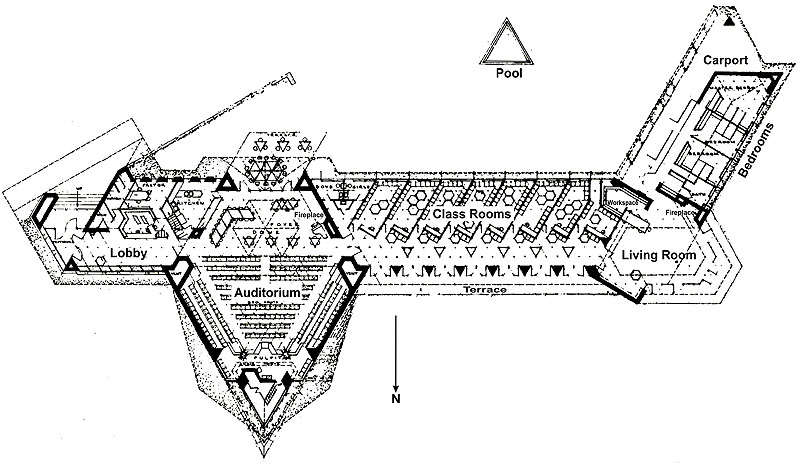
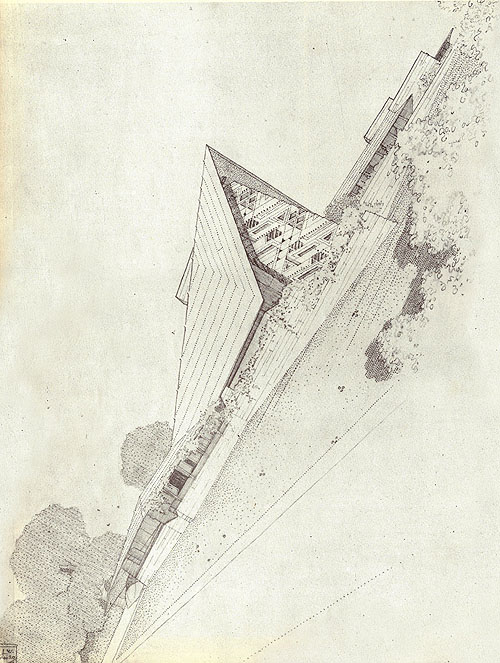
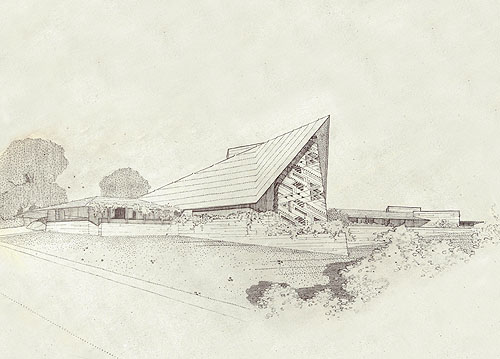
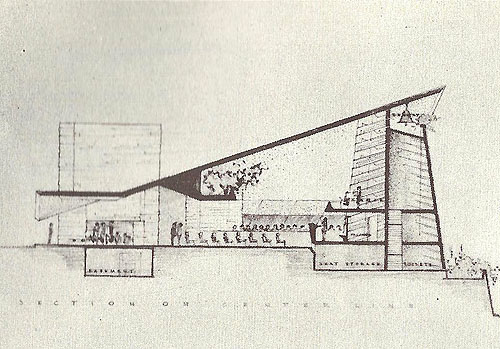
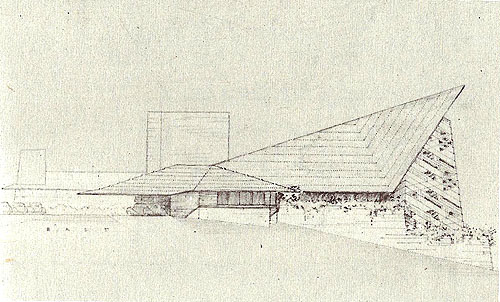

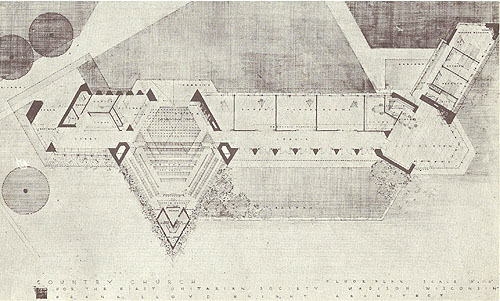
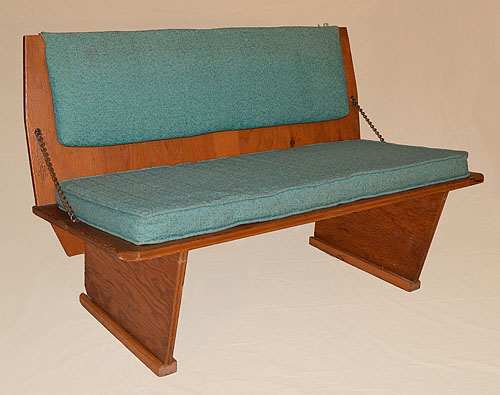
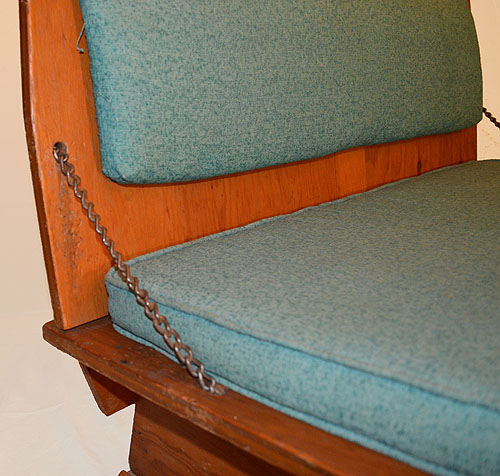
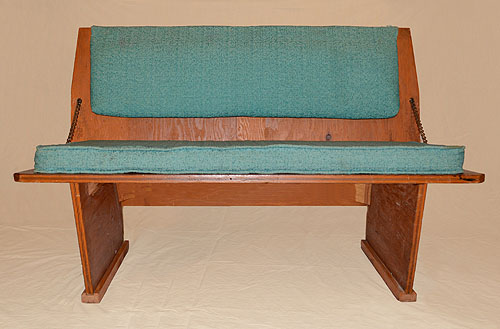
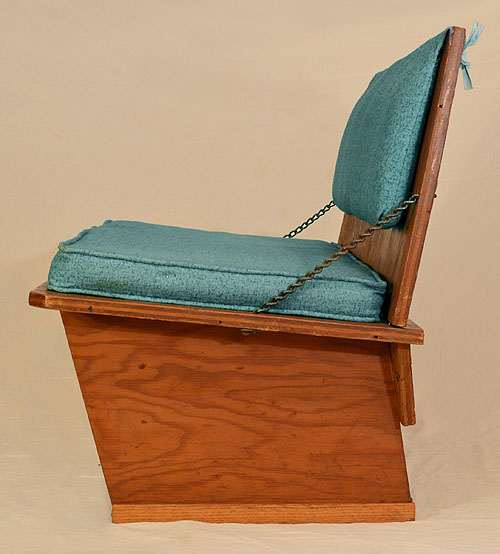
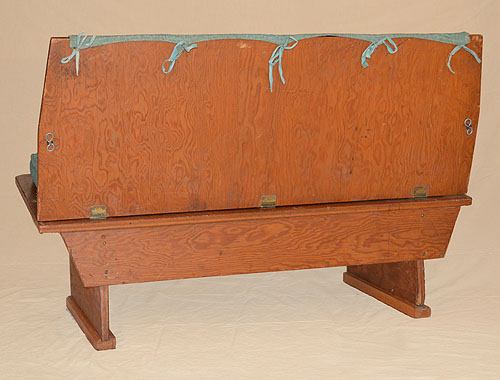
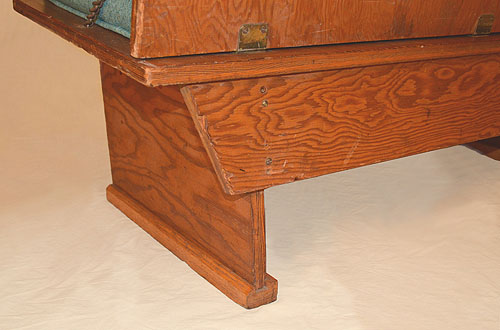
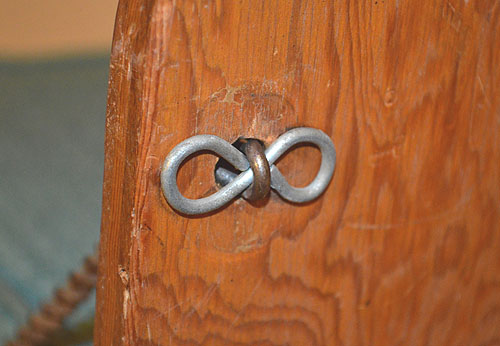
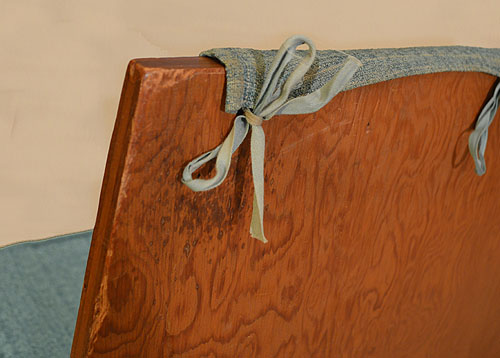
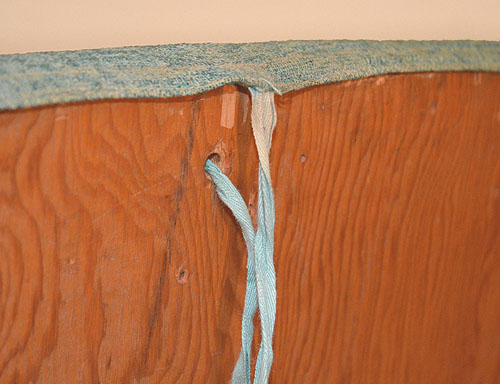
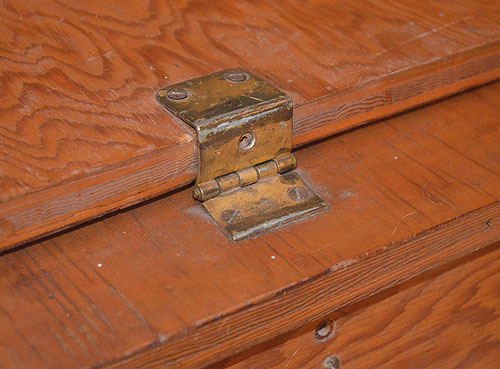
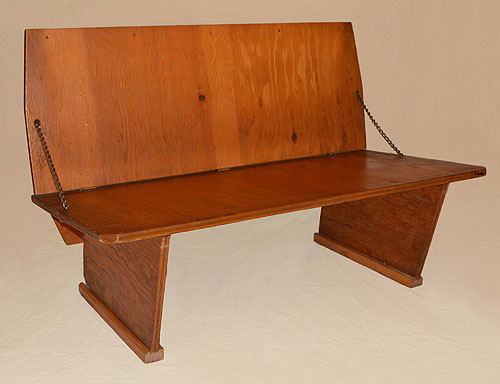
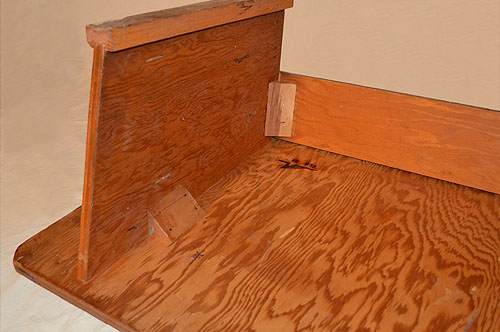
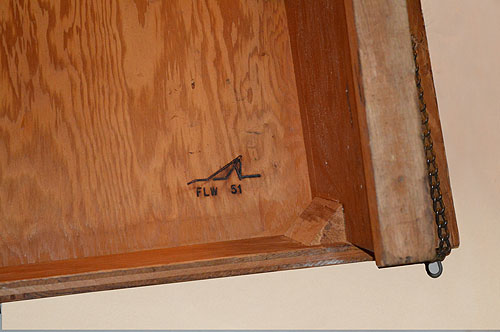
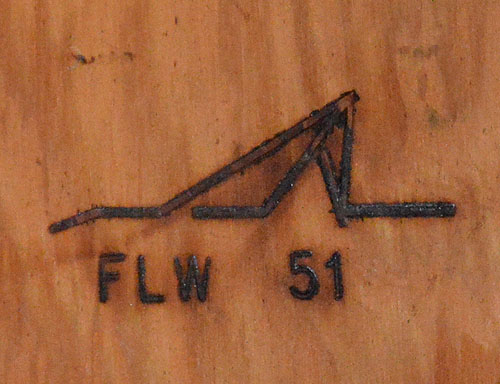
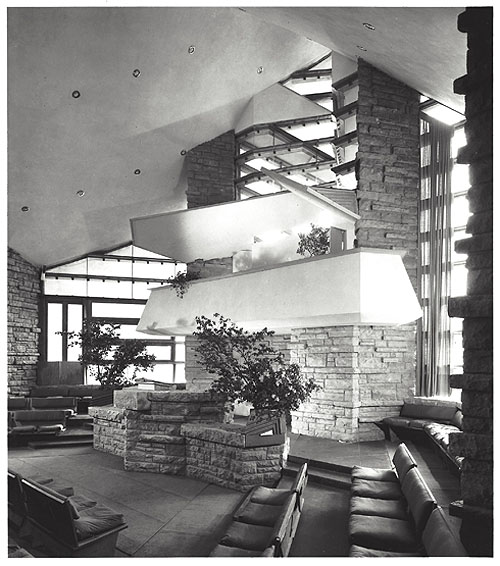
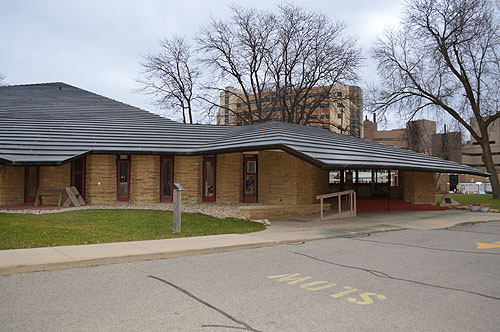
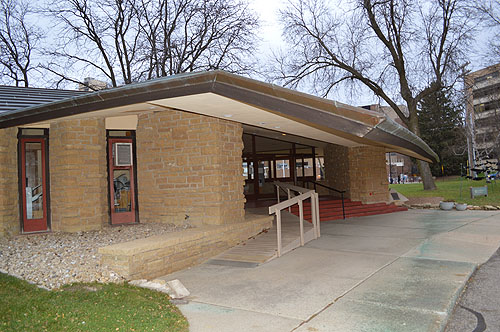
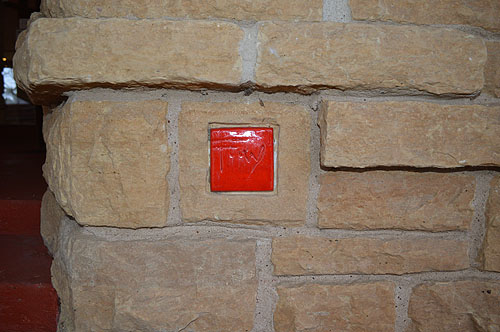
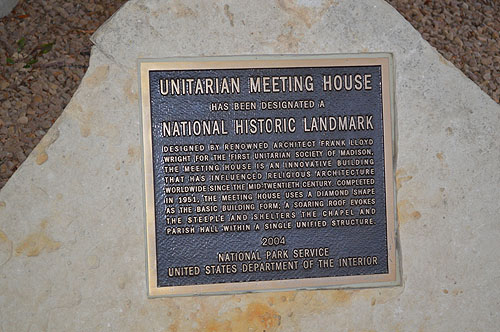
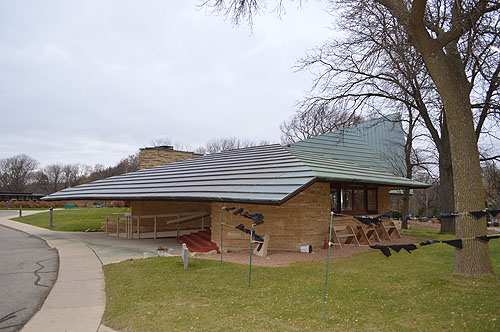
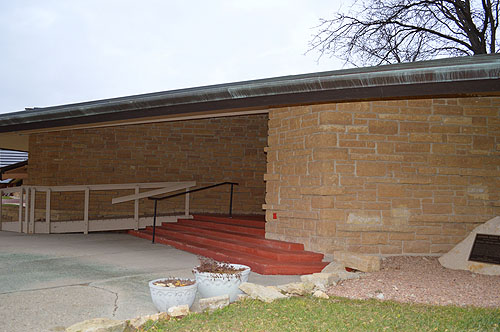
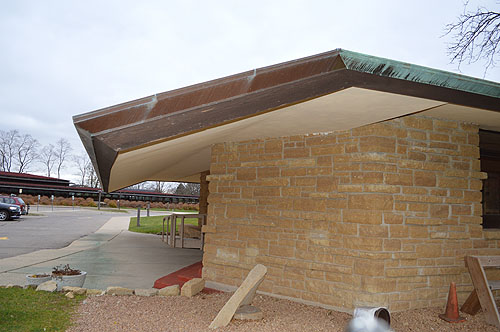
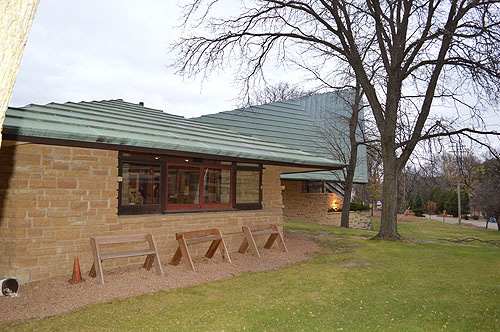
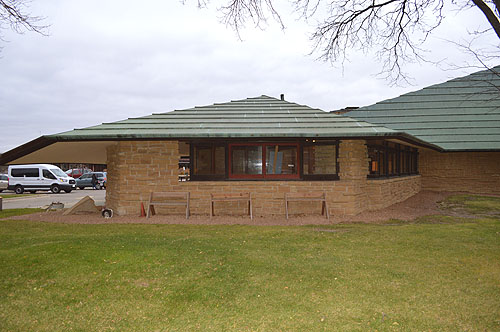
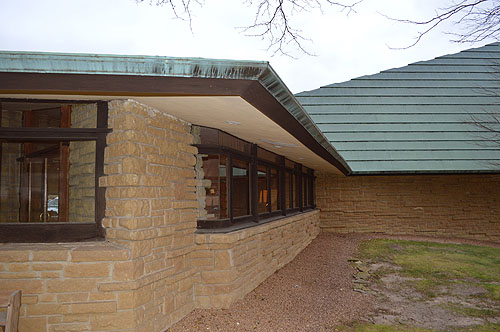
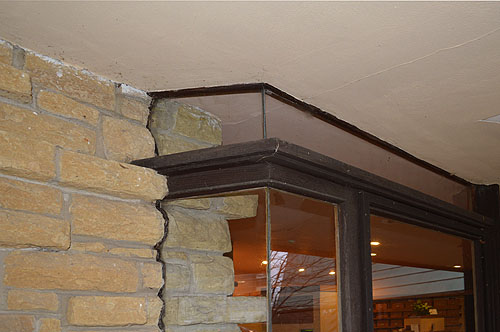
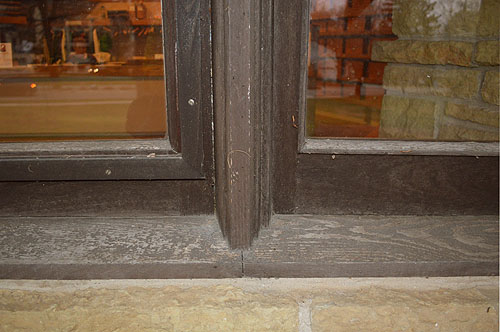
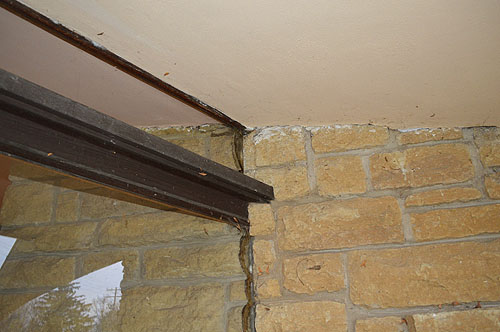
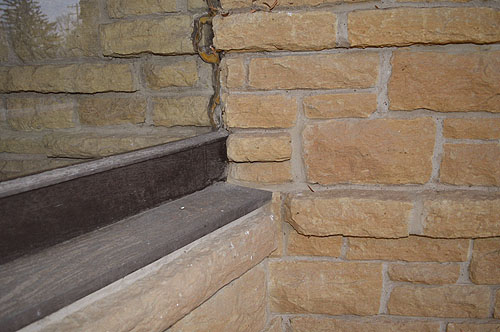
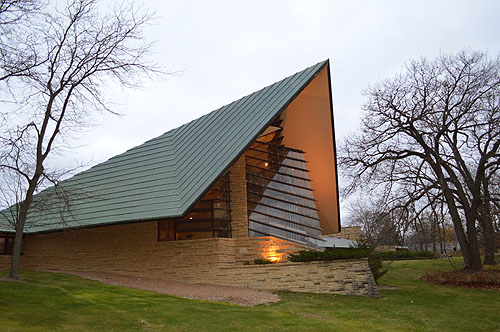
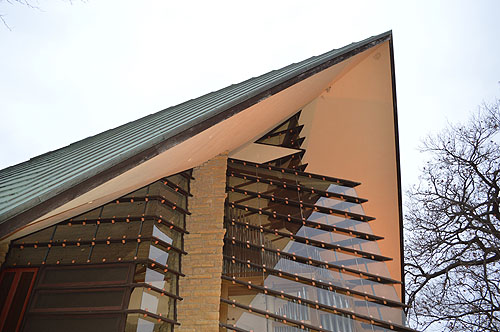
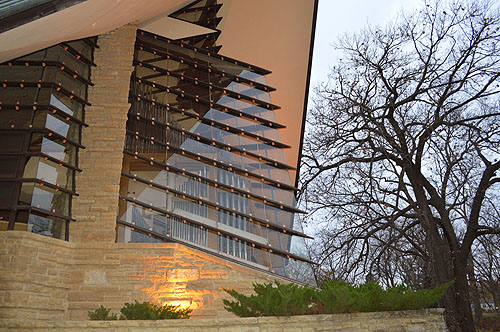
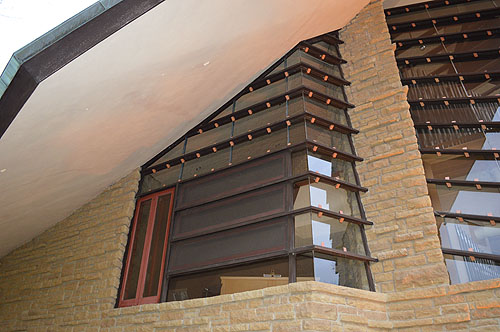
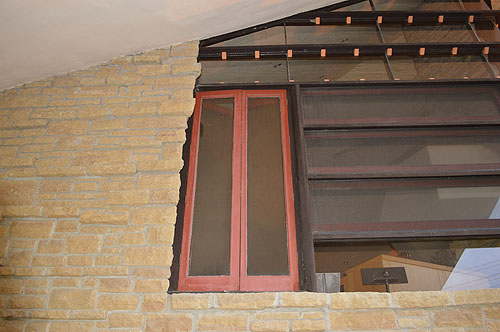
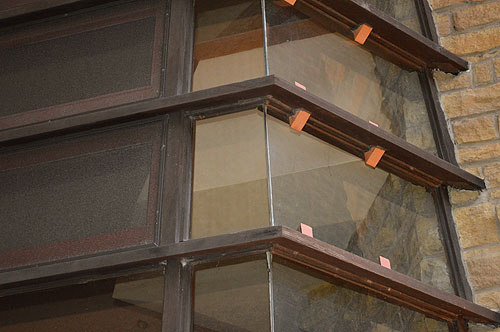 his
buil
his
buil